Internal Analysis of Celanese Corporation: A Detailed Report
VerifiedAdded on 2019/09/22
|38
|6999
|339
Report
AI Summary
This comprehensive internal analysis report examines Celanese Corporation, delving into its organizational structure, corporate mission, products and services, leadership, and organizational culture. It provides a detailed overview of the company's tangible and intangible resources, core competencies, and value chain activities, including primary and support activities. The report further analyzes Celanese's financial performance, covering valuation, growth, profitability, financial strength, and management efficiency. A summary of strengths and weaknesses is presented, along with references. The report aims to provide insights into Celanese's strategic positioning and overall business performance. The analysis includes a BCG matrix assessment of its product portfolio and evaluates the roles of key executives, the company's values, norms, rituals, and its flat organizational structure.
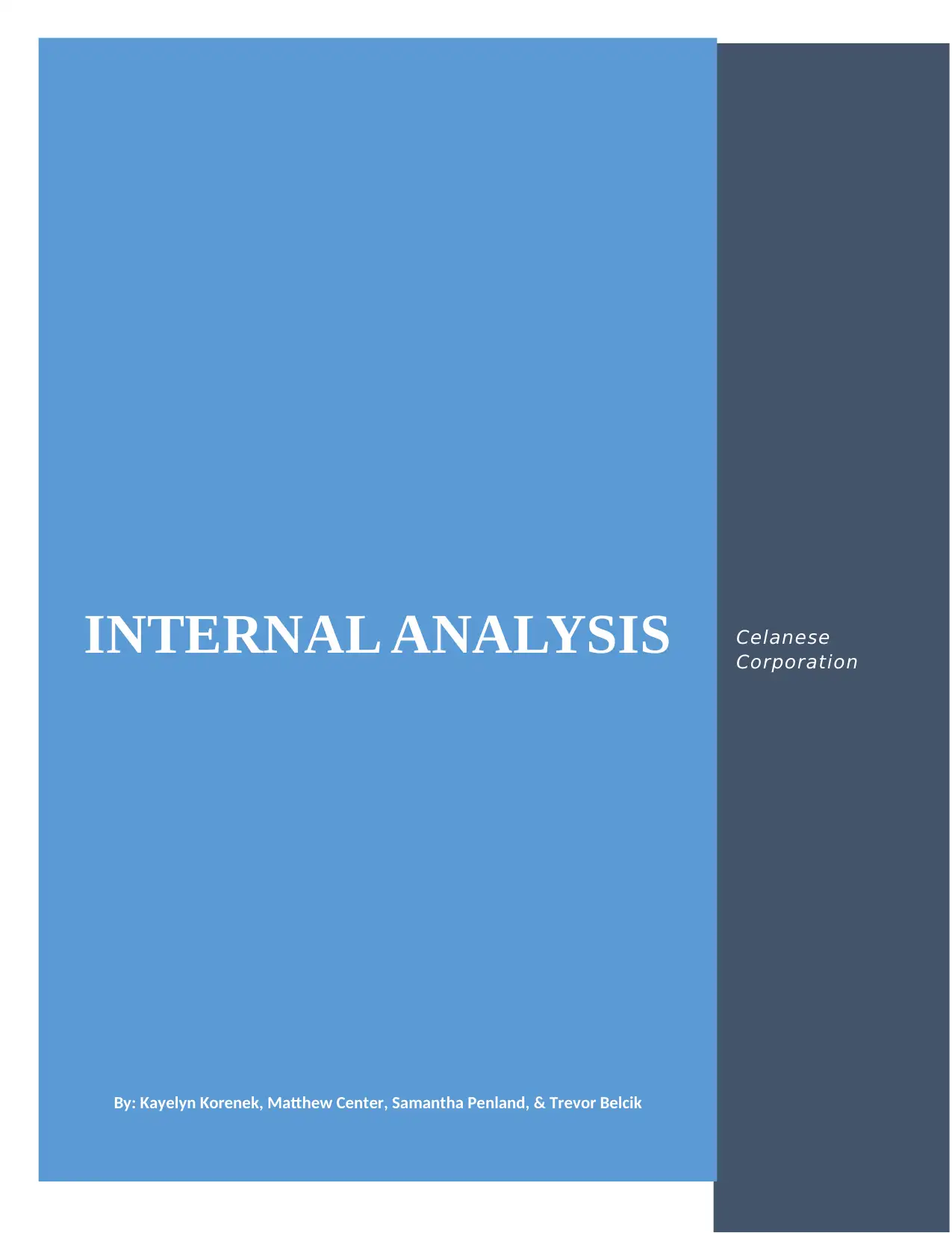
Celanese
Corporation
INTERNAL ANALYSIS
By: Kayelyn Korenek, Matthew Center, Samantha Penland, & Trevor Belcik
Corporation
INTERNAL ANALYSIS
By: Kayelyn Korenek, Matthew Center, Samantha Penland, & Trevor Belcik
Secure Best Marks with AI Grader
Need help grading? Try our AI Grader for instant feedback on your assignments.
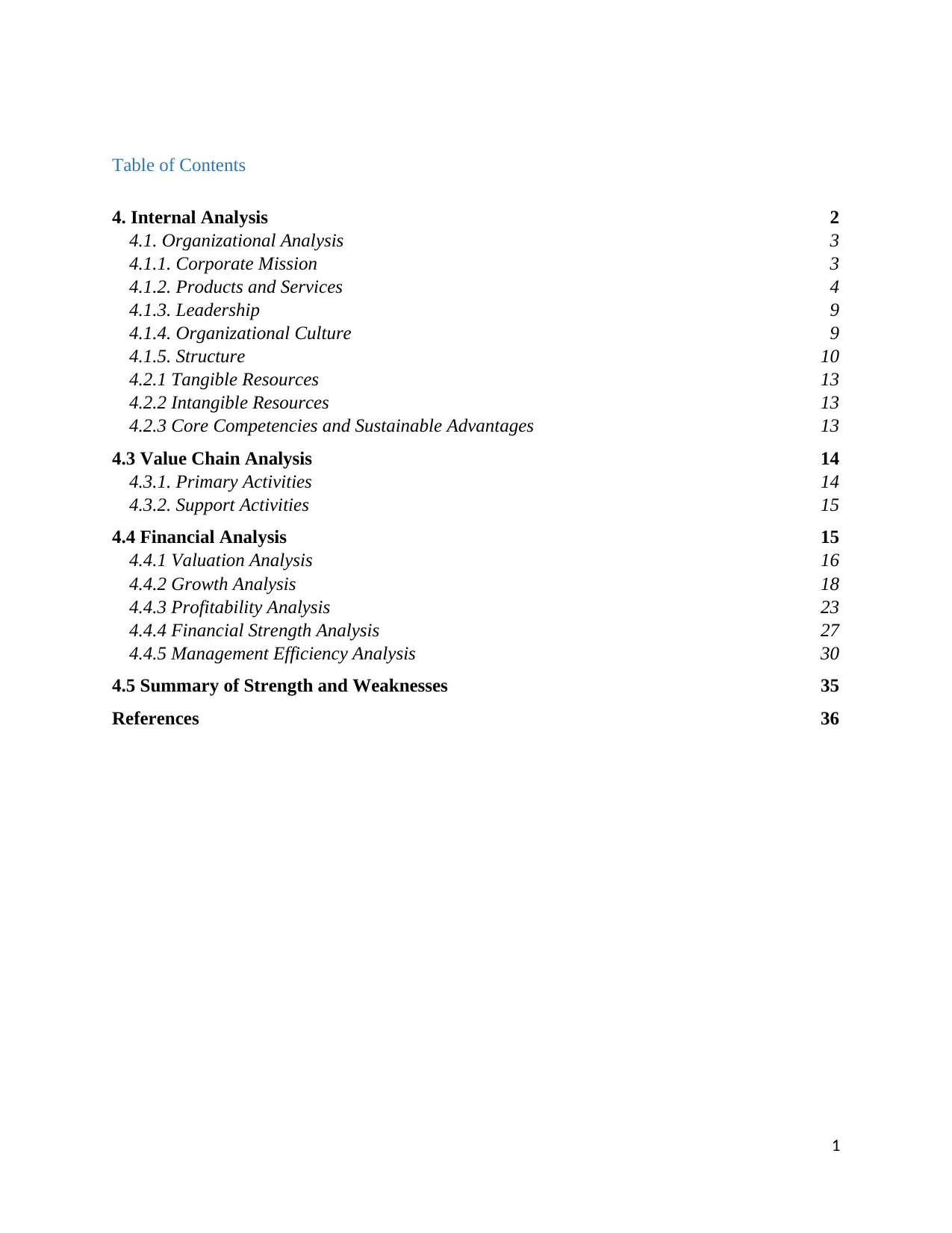
Table of Contents
4. Internal Analysis 2
4.1. Organizational Analysis 3
4.1.1. Corporate Mission 3
4.1.2. Products and Services 4
4.1.3. Leadership 9
4.1.4. Organizational Culture 9
4.1.5. Structure 10
4.2.1 Tangible Resources 13
4.2.2 Intangible Resources 13
4.2.3 Core Competencies and Sustainable Advantages 13
4.3 Value Chain Analysis 14
4.3.1. Primary Activities 14
4.3.2. Support Activities 15
4.4 Financial Analysis 15
4.4.1 Valuation Analysis 16
4.4.2 Growth Analysis 18
4.4.3 Profitability Analysis 23
4.4.4 Financial Strength Analysis 27
4.4.5 Management Efficiency Analysis 30
4.5 Summary of Strength and Weaknesses 35
References 36
1
4. Internal Analysis 2
4.1. Organizational Analysis 3
4.1.1. Corporate Mission 3
4.1.2. Products and Services 4
4.1.3. Leadership 9
4.1.4. Organizational Culture 9
4.1.5. Structure 10
4.2.1 Tangible Resources 13
4.2.2 Intangible Resources 13
4.2.3 Core Competencies and Sustainable Advantages 13
4.3 Value Chain Analysis 14
4.3.1. Primary Activities 14
4.3.2. Support Activities 15
4.4 Financial Analysis 15
4.4.1 Valuation Analysis 16
4.4.2 Growth Analysis 18
4.4.3 Profitability Analysis 23
4.4.4 Financial Strength Analysis 27
4.4.5 Management Efficiency Analysis 30
4.5 Summary of Strength and Weaknesses 35
References 36
1
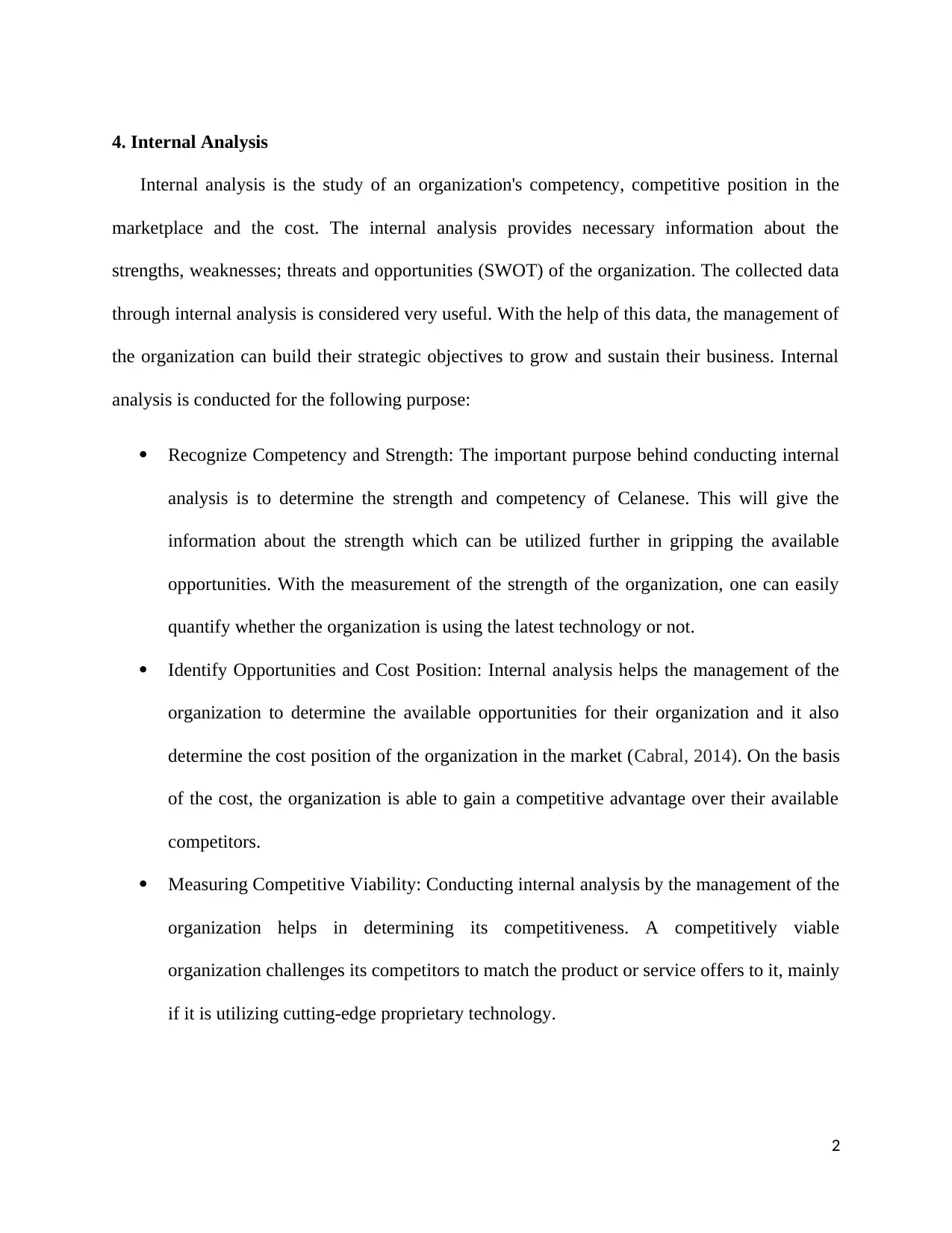
4. Internal Analysis
Internal analysis is the study of an organization's competency, competitive position in the
marketplace and the cost. The internal analysis provides necessary information about the
strengths, weaknesses; threats and opportunities (SWOT) of the organization. The collected data
through internal analysis is considered very useful. With the help of this data, the management of
the organization can build their strategic objectives to grow and sustain their business. Internal
analysis is conducted for the following purpose:
Recognize Competency and Strength: The important purpose behind conducting internal
analysis is to determine the strength and competency of Celanese. This will give the
information about the strength which can be utilized further in gripping the available
opportunities. With the measurement of the strength of the organization, one can easily
quantify whether the organization is using the latest technology or not.
Identify Opportunities and Cost Position: Internal analysis helps the management of the
organization to determine the available opportunities for their organization and it also
determine the cost position of the organization in the market (Cabral, 2014). On the basis
of the cost, the organization is able to gain a competitive advantage over their available
competitors.
Measuring Competitive Viability: Conducting internal analysis by the management of the
organization helps in determining its competitiveness. A competitively viable
organization challenges its competitors to match the product or service offers to it, mainly
if it is utilizing cutting-edge proprietary technology.
2
Internal analysis is the study of an organization's competency, competitive position in the
marketplace and the cost. The internal analysis provides necessary information about the
strengths, weaknesses; threats and opportunities (SWOT) of the organization. The collected data
through internal analysis is considered very useful. With the help of this data, the management of
the organization can build their strategic objectives to grow and sustain their business. Internal
analysis is conducted for the following purpose:
Recognize Competency and Strength: The important purpose behind conducting internal
analysis is to determine the strength and competency of Celanese. This will give the
information about the strength which can be utilized further in gripping the available
opportunities. With the measurement of the strength of the organization, one can easily
quantify whether the organization is using the latest technology or not.
Identify Opportunities and Cost Position: Internal analysis helps the management of the
organization to determine the available opportunities for their organization and it also
determine the cost position of the organization in the market (Cabral, 2014). On the basis
of the cost, the organization is able to gain a competitive advantage over their available
competitors.
Measuring Competitive Viability: Conducting internal analysis by the management of the
organization helps in determining its competitiveness. A competitively viable
organization challenges its competitors to match the product or service offers to it, mainly
if it is utilizing cutting-edge proprietary technology.
2
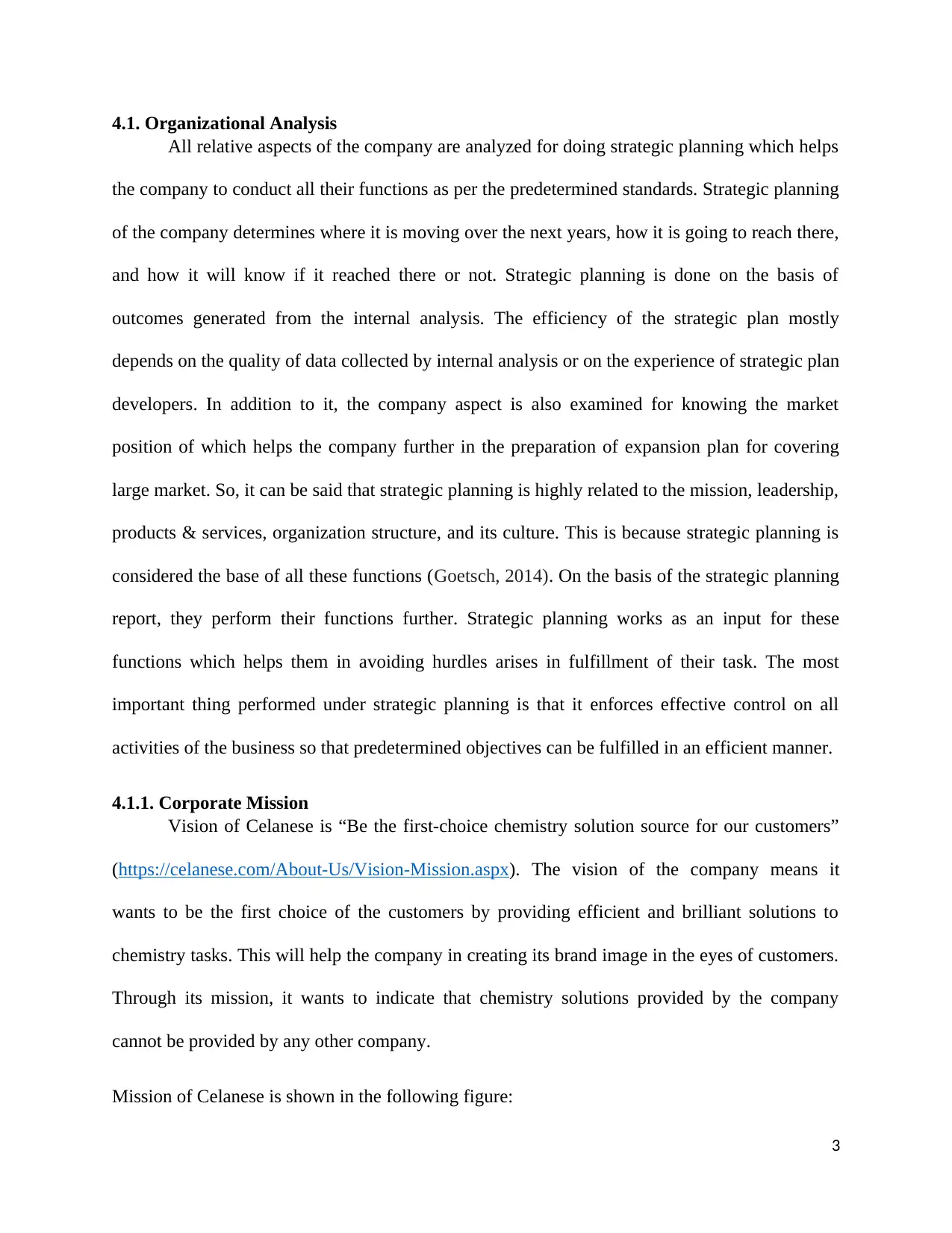
4.1. Organizational Analysis
All relative aspects of the company are analyzed for doing strategic planning which helps
the company to conduct all their functions as per the predetermined standards. Strategic planning
of the company determines where it is moving over the next years, how it is going to reach there,
and how it will know if it reached there or not. Strategic planning is done on the basis of
outcomes generated from the internal analysis. The efficiency of the strategic plan mostly
depends on the quality of data collected by internal analysis or on the experience of strategic plan
developers. In addition to it, the company aspect is also examined for knowing the market
position of which helps the company further in the preparation of expansion plan for covering
large market. So, it can be said that strategic planning is highly related to the mission, leadership,
products & services, organization structure, and its culture. This is because strategic planning is
considered the base of all these functions (Goetsch, 2014). On the basis of the strategic planning
report, they perform their functions further. Strategic planning works as an input for these
functions which helps them in avoiding hurdles arises in fulfillment of their task. The most
important thing performed under strategic planning is that it enforces effective control on all
activities of the business so that predetermined objectives can be fulfilled in an efficient manner.
4.1.1. Corporate Mission
Vision of Celanese is “Be the first-choice chemistry solution source for our customers”
(https://celanese.com/About-Us/Vision-Mission.aspx). The vision of the company means it
wants to be the first choice of the customers by providing efficient and brilliant solutions to
chemistry tasks. This will help the company in creating its brand image in the eyes of customers.
Through its mission, it wants to indicate that chemistry solutions provided by the company
cannot be provided by any other company.
Mission of Celanese is shown in the following figure:
3
All relative aspects of the company are analyzed for doing strategic planning which helps
the company to conduct all their functions as per the predetermined standards. Strategic planning
of the company determines where it is moving over the next years, how it is going to reach there,
and how it will know if it reached there or not. Strategic planning is done on the basis of
outcomes generated from the internal analysis. The efficiency of the strategic plan mostly
depends on the quality of data collected by internal analysis or on the experience of strategic plan
developers. In addition to it, the company aspect is also examined for knowing the market
position of which helps the company further in the preparation of expansion plan for covering
large market. So, it can be said that strategic planning is highly related to the mission, leadership,
products & services, organization structure, and its culture. This is because strategic planning is
considered the base of all these functions (Goetsch, 2014). On the basis of the strategic planning
report, they perform their functions further. Strategic planning works as an input for these
functions which helps them in avoiding hurdles arises in fulfillment of their task. The most
important thing performed under strategic planning is that it enforces effective control on all
activities of the business so that predetermined objectives can be fulfilled in an efficient manner.
4.1.1. Corporate Mission
Vision of Celanese is “Be the first-choice chemistry solution source for our customers”
(https://celanese.com/About-Us/Vision-Mission.aspx). The vision of the company means it
wants to be the first choice of the customers by providing efficient and brilliant solutions to
chemistry tasks. This will help the company in creating its brand image in the eyes of customers.
Through its mission, it wants to indicate that chemistry solutions provided by the company
cannot be provided by any other company.
Mission of Celanese is shown in the following figure:
3
Secure Best Marks with AI Grader
Need help grading? Try our AI Grader for instant feedback on your assignments.
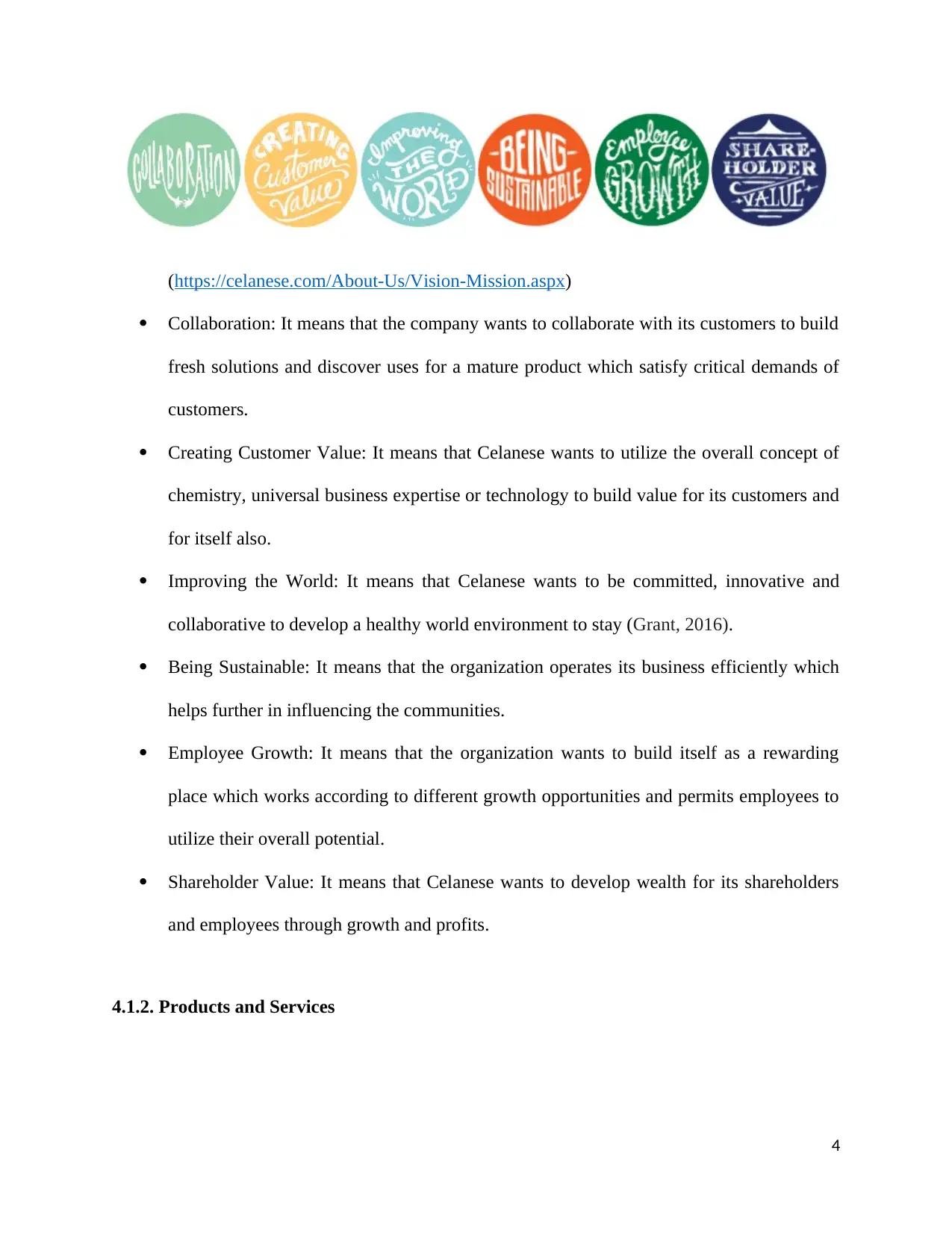
(https://celanese.com/About-Us/Vision-Mission.aspx)
Collaboration: It means that the company wants to collaborate with its customers to build
fresh solutions and discover uses for a mature product which satisfy critical demands of
customers.
Creating Customer Value: It means that Celanese wants to utilize the overall concept of
chemistry, universal business expertise or technology to build value for its customers and
for itself also.
Improving the World: It means that Celanese wants to be committed, innovative and
collaborative to develop a healthy world environment to stay (Grant, 2016).
Being Sustainable: It means that the organization operates its business efficiently which
helps further in influencing the communities.
Employee Growth: It means that the organization wants to build itself as a rewarding
place which works according to different growth opportunities and permits employees to
utilize their overall potential.
Shareholder Value: It means that Celanese wants to develop wealth for its shareholders
and employees through growth and profits.
4.1.2. Products and Services
4
Collaboration: It means that the company wants to collaborate with its customers to build
fresh solutions and discover uses for a mature product which satisfy critical demands of
customers.
Creating Customer Value: It means that Celanese wants to utilize the overall concept of
chemistry, universal business expertise or technology to build value for its customers and
for itself also.
Improving the World: It means that Celanese wants to be committed, innovative and
collaborative to develop a healthy world environment to stay (Grant, 2016).
Being Sustainable: It means that the organization operates its business efficiently which
helps further in influencing the communities.
Employee Growth: It means that the organization wants to build itself as a rewarding
place which works according to different growth opportunities and permits employees to
utilize their overall potential.
Shareholder Value: It means that Celanese wants to develop wealth for its shareholders
and employees through growth and profits.
4.1.2. Products and Services
4
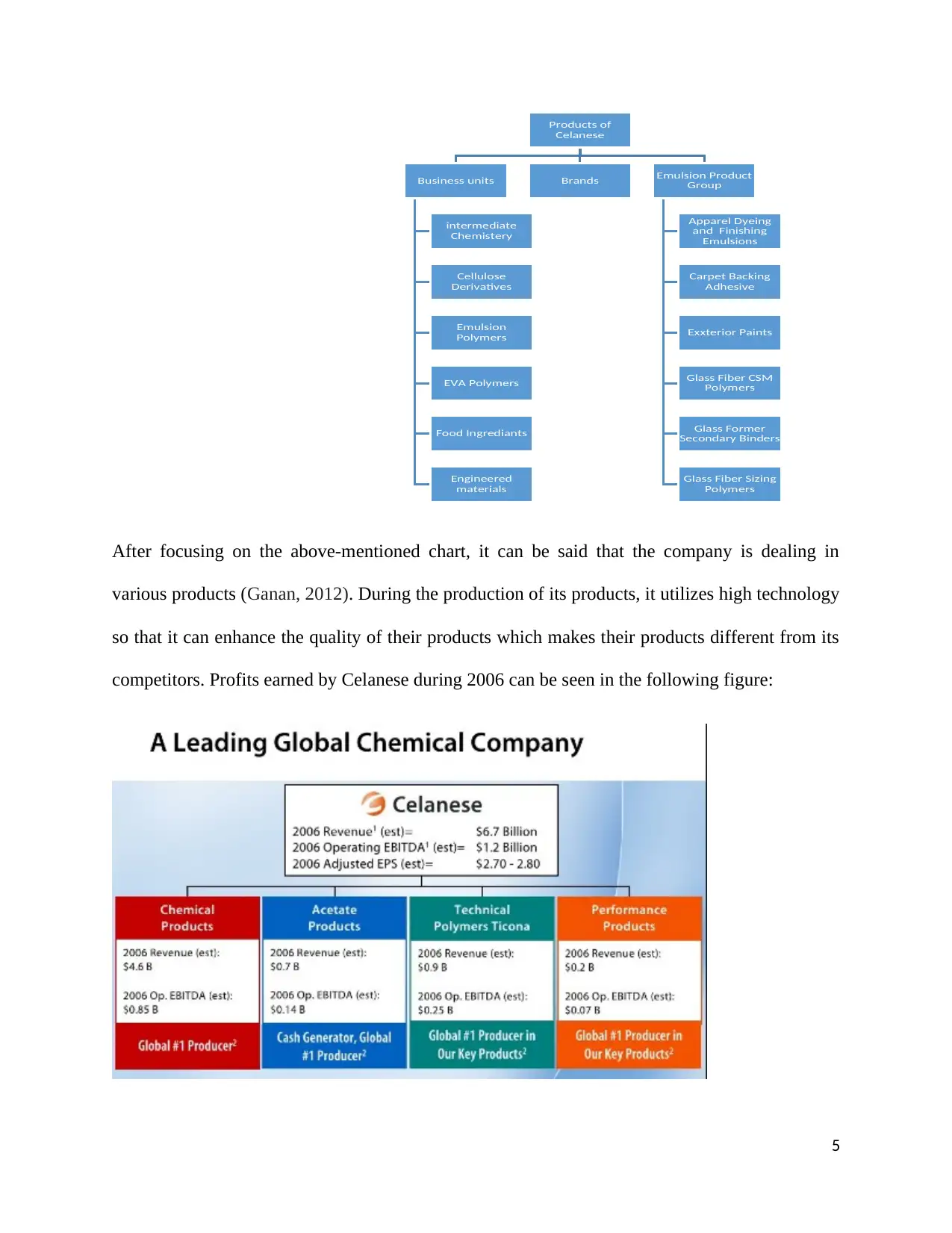
After focusing on the above-mentioned chart, it can be said that the company is dealing in
various products (Ganan, 2012). During the production of its products, it utilizes high technology
so that it can enhance the quality of their products which makes their products different from its
competitors. Profits earned by Celanese during 2006 can be seen in the following figure:
5
Products of
Celanese
Business units
intermediate
Chemistery
Cellulose
Derivatives
Emulsion
Polymers
EVA Polymers
Food Ingrediants
Engineered
materials
Brands Emulsion Product
Group
Apparel Dyeing
and Finishing
Emulsions
Carpet Backing
Adhesive
Exxterior Paints
Glass Fiber CSM
Polymers
Glass Former
Secondary Binders
Glass Fiber Sizing
Polymers
various products (Ganan, 2012). During the production of its products, it utilizes high technology
so that it can enhance the quality of their products which makes their products different from its
competitors. Profits earned by Celanese during 2006 can be seen in the following figure:
5
Products of
Celanese
Business units
intermediate
Chemistery
Cellulose
Derivatives
Emulsion
Polymers
EVA Polymers
Food Ingrediants
Engineered
materials
Brands Emulsion Product
Group
Apparel Dyeing
and Finishing
Emulsions
Carpet Backing
Adhesive
Exxterior Paints
Glass Fiber CSM
Polymers
Glass Former
Secondary Binders
Glass Fiber Sizing
Polymers
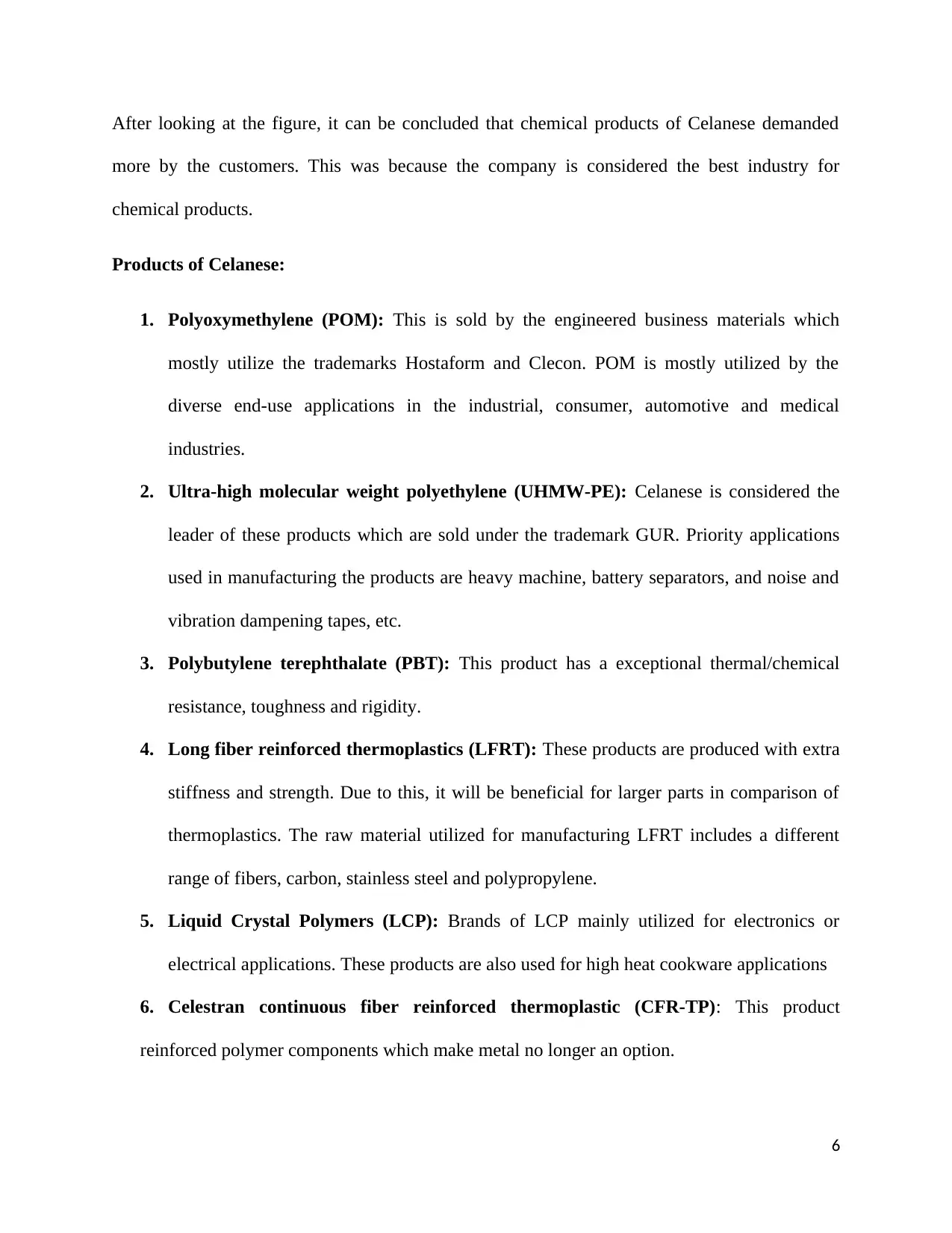
After looking at the figure, it can be concluded that chemical products of Celanese demanded
more by the customers. This was because the company is considered the best industry for
chemical products.
Products of Celanese:
1. Polyoxymethylene (POM): This is sold by the engineered business materials which
mostly utilize the trademarks Hostaform and Clecon. POM is mostly utilized by the
diverse end-use applications in the industrial, consumer, automotive and medical
industries.
2. Ultra-high molecular weight polyethylene (UHMW-PE): Celanese is considered the
leader of these products which are sold under the trademark GUR. Priority applications
used in manufacturing the products are heavy machine, battery separators, and noise and
vibration dampening tapes, etc.
3. Polybutylene terephthalate (PBT): This product has a exceptional thermal/chemical
resistance, toughness and rigidity.
4. Long fiber reinforced thermoplastics (LFRT): These products are produced with extra
stiffness and strength. Due to this, it will be beneficial for larger parts in comparison of
thermoplastics. The raw material utilized for manufacturing LFRT includes a different
range of fibers, carbon, stainless steel and polypropylene.
5. Liquid Crystal Polymers (LCP): Brands of LCP mainly utilized for electronics or
electrical applications. These products are also used for high heat cookware applications
6. Celestran continuous fiber reinforced thermoplastic (CFR-TP): This product
reinforced polymer components which make metal no longer an option.
6
more by the customers. This was because the company is considered the best industry for
chemical products.
Products of Celanese:
1. Polyoxymethylene (POM): This is sold by the engineered business materials which
mostly utilize the trademarks Hostaform and Clecon. POM is mostly utilized by the
diverse end-use applications in the industrial, consumer, automotive and medical
industries.
2. Ultra-high molecular weight polyethylene (UHMW-PE): Celanese is considered the
leader of these products which are sold under the trademark GUR. Priority applications
used in manufacturing the products are heavy machine, battery separators, and noise and
vibration dampening tapes, etc.
3. Polybutylene terephthalate (PBT): This product has a exceptional thermal/chemical
resistance, toughness and rigidity.
4. Long fiber reinforced thermoplastics (LFRT): These products are produced with extra
stiffness and strength. Due to this, it will be beneficial for larger parts in comparison of
thermoplastics. The raw material utilized for manufacturing LFRT includes a different
range of fibers, carbon, stainless steel and polypropylene.
5. Liquid Crystal Polymers (LCP): Brands of LCP mainly utilized for electronics or
electrical applications. These products are also used for high heat cookware applications
6. Celestran continuous fiber reinforced thermoplastic (CFR-TP): This product
reinforced polymer components which make metal no longer an option.
6
Paraphrase This Document
Need a fresh take? Get an instant paraphrase of this document with our AI Paraphraser
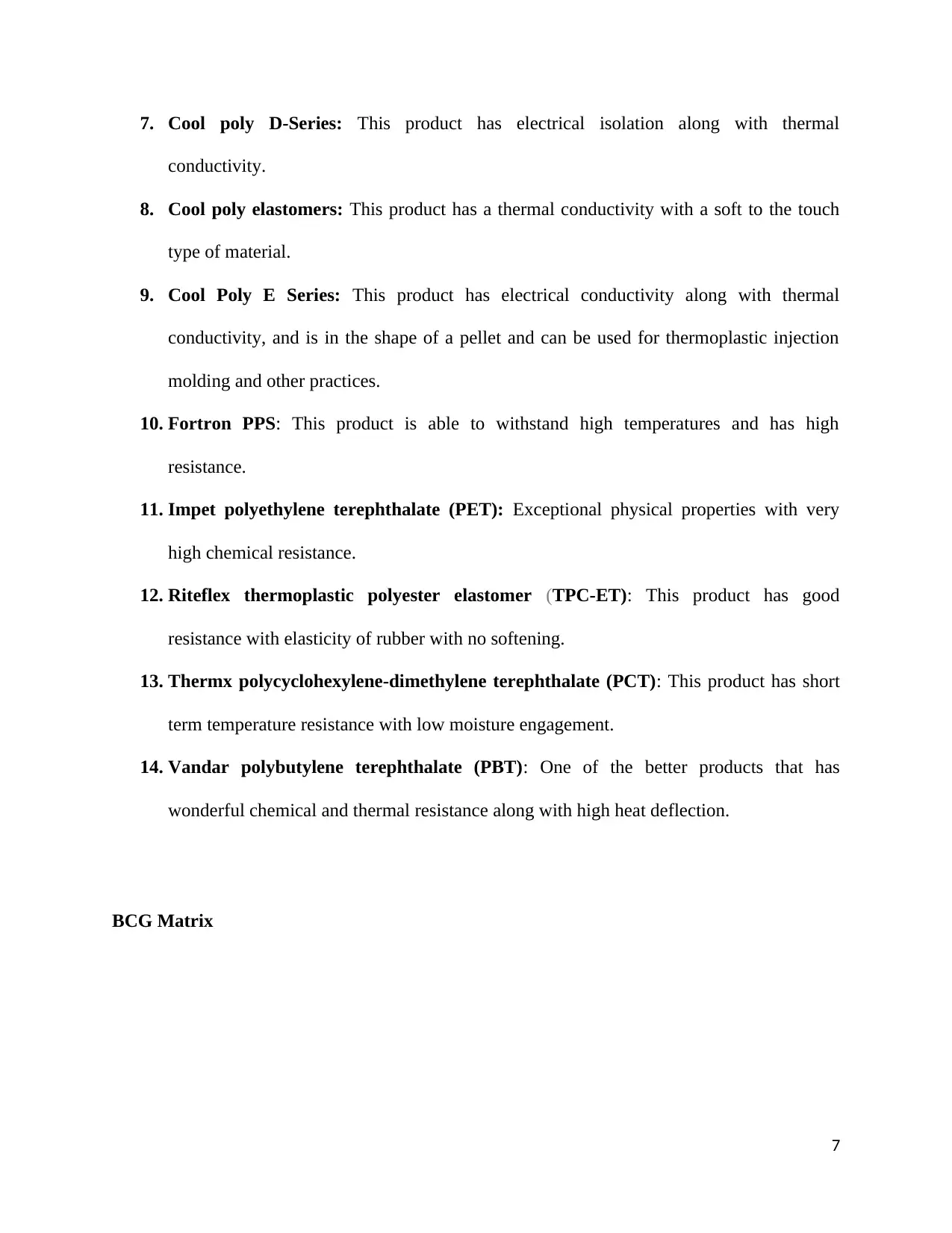
7. Cool poly D-Series: This product has electrical isolation along with thermal
conductivity.
8. Cool poly elastomers: This product has a thermal conductivity with a soft to the touch
type of material.
9. Cool Poly E Series: This product has electrical conductivity along with thermal
conductivity, and is in the shape of a pellet and can be used for thermoplastic injection
molding and other practices.
10. Fortron PPS: This product is able to withstand high temperatures and has high
resistance.
11. Impet polyethylene terephthalate (PET): Exceptional physical properties with very
high chemical resistance.
12. Riteflex thermoplastic polyester elastomer (TPC-ET): This product has good
resistance with elasticity of rubber with no softening.
13. Thermx polycyclohexylene-dimethylene terephthalate (PCT): This product has short
term temperature resistance with low moisture engagement.
14. Vandar polybutylene terephthalate (PBT): One of the better products that has
wonderful chemical and thermal resistance along with high heat deflection.
BCG Matrix
7
conductivity.
8. Cool poly elastomers: This product has a thermal conductivity with a soft to the touch
type of material.
9. Cool Poly E Series: This product has electrical conductivity along with thermal
conductivity, and is in the shape of a pellet and can be used for thermoplastic injection
molding and other practices.
10. Fortron PPS: This product is able to withstand high temperatures and has high
resistance.
11. Impet polyethylene terephthalate (PET): Exceptional physical properties with very
high chemical resistance.
12. Riteflex thermoplastic polyester elastomer (TPC-ET): This product has good
resistance with elasticity of rubber with no softening.
13. Thermx polycyclohexylene-dimethylene terephthalate (PCT): This product has short
term temperature resistance with low moisture engagement.
14. Vandar polybutylene terephthalate (PBT): One of the better products that has
wonderful chemical and thermal resistance along with high heat deflection.
BCG Matrix
7
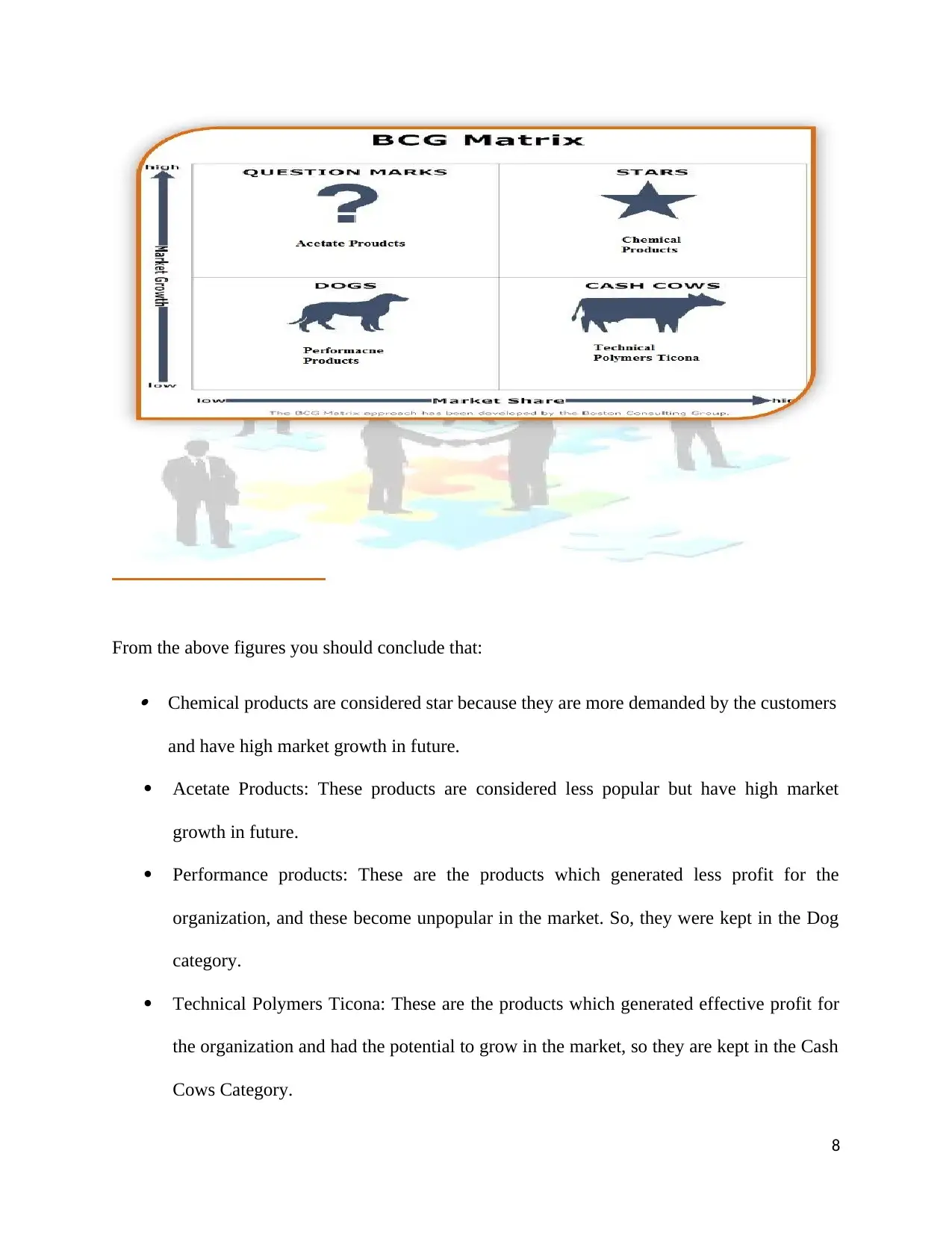
From the above figures you should conclude that:
Chemical products are considered star because they are more demanded by the customers
and have high market growth in future.
Acetate Products: These products are considered less popular but have high market
growth in future.
Performance products: These are the products which generated less profit for the
organization, and these become unpopular in the market. So, they were kept in the Dog
category.
Technical Polymers Ticona: These are the products which generated effective profit for
the organization and had the potential to grow in the market, so they are kept in the Cash
Cows Category.
8
Chemical products are considered star because they are more demanded by the customers
and have high market growth in future.
Acetate Products: These products are considered less popular but have high market
growth in future.
Performance products: These are the products which generated less profit for the
organization, and these become unpopular in the market. So, they were kept in the Dog
category.
Technical Polymers Ticona: These are the products which generated effective profit for
the organization and had the potential to grow in the market, so they are kept in the Cash
Cows Category.
8
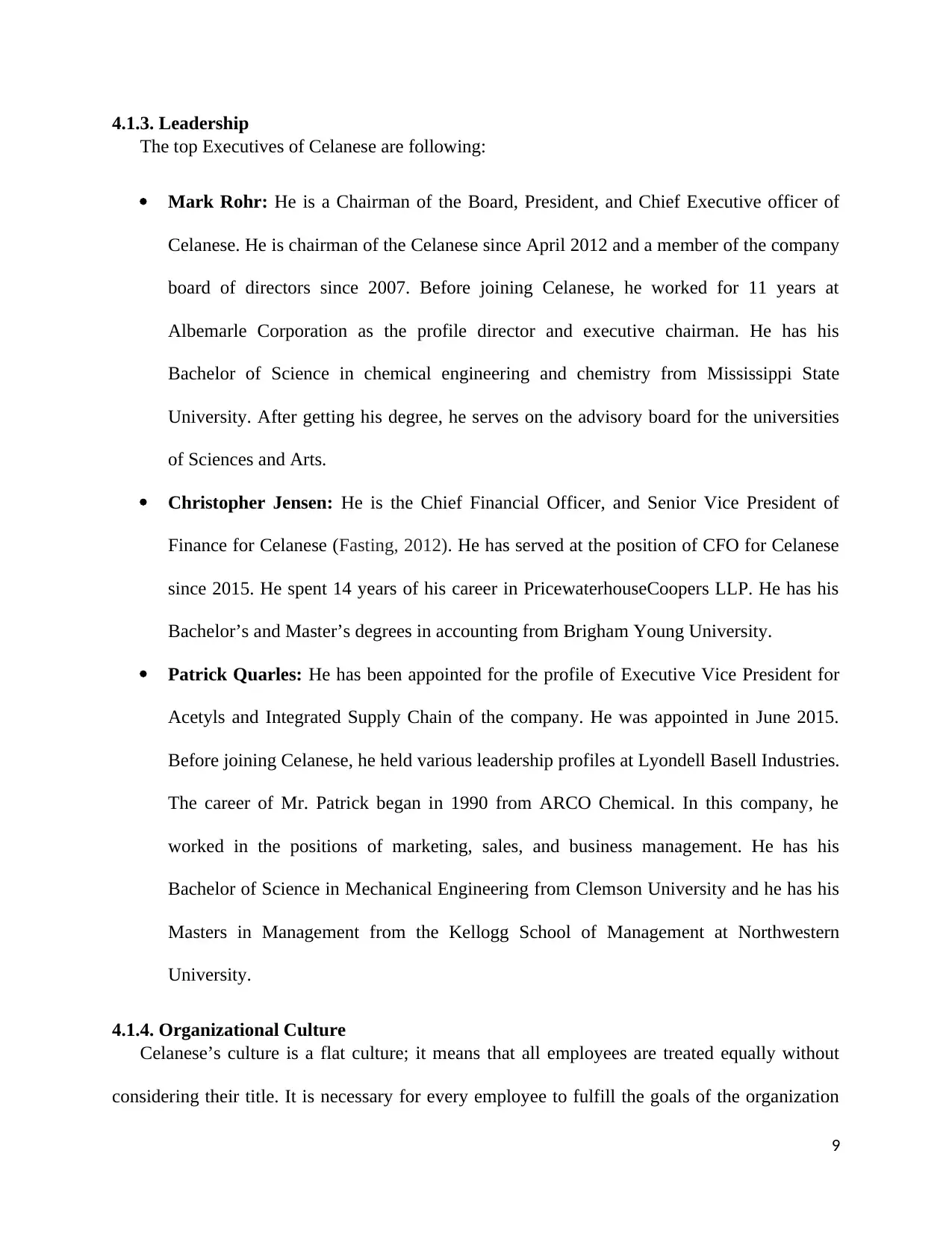
4.1.3. Leadership
The top Executives of Celanese are following:
Mark Rohr: He is a Chairman of the Board, President, and Chief Executive officer of
Celanese. He is chairman of the Celanese since April 2012 and a member of the company
board of directors since 2007. Before joining Celanese, he worked for 11 years at
Albemarle Corporation as the profile director and executive chairman. He has his
Bachelor of Science in chemical engineering and chemistry from Mississippi State
University. After getting his degree, he serves on the advisory board for the universities
of Sciences and Arts.
Christopher Jensen: He is the Chief Financial Officer, and Senior Vice President of
Finance for Celanese (Fasting, 2012). He has served at the position of CFO for Celanese
since 2015. He spent 14 years of his career in PricewaterhouseCoopers LLP. He has his
Bachelor’s and Master’s degrees in accounting from Brigham Young University.
Patrick Quarles: He has been appointed for the profile of Executive Vice President for
Acetyls and Integrated Supply Chain of the company. He was appointed in June 2015.
Before joining Celanese, he held various leadership profiles at Lyondell Basell Industries.
The career of Mr. Patrick began in 1990 from ARCO Chemical. In this company, he
worked in the positions of marketing, sales, and business management. He has his
Bachelor of Science in Mechanical Engineering from Clemson University and he has his
Masters in Management from the Kellogg School of Management at Northwestern
University.
4.1.4. Organizational Culture
Celanese’s culture is a flat culture; it means that all employees are treated equally without
considering their title. It is necessary for every employee to fulfill the goals of the organization
9
The top Executives of Celanese are following:
Mark Rohr: He is a Chairman of the Board, President, and Chief Executive officer of
Celanese. He is chairman of the Celanese since April 2012 and a member of the company
board of directors since 2007. Before joining Celanese, he worked for 11 years at
Albemarle Corporation as the profile director and executive chairman. He has his
Bachelor of Science in chemical engineering and chemistry from Mississippi State
University. After getting his degree, he serves on the advisory board for the universities
of Sciences and Arts.
Christopher Jensen: He is the Chief Financial Officer, and Senior Vice President of
Finance for Celanese (Fasting, 2012). He has served at the position of CFO for Celanese
since 2015. He spent 14 years of his career in PricewaterhouseCoopers LLP. He has his
Bachelor’s and Master’s degrees in accounting from Brigham Young University.
Patrick Quarles: He has been appointed for the profile of Executive Vice President for
Acetyls and Integrated Supply Chain of the company. He was appointed in June 2015.
Before joining Celanese, he held various leadership profiles at Lyondell Basell Industries.
The career of Mr. Patrick began in 1990 from ARCO Chemical. In this company, he
worked in the positions of marketing, sales, and business management. He has his
Bachelor of Science in Mechanical Engineering from Clemson University and he has his
Masters in Management from the Kellogg School of Management at Northwestern
University.
4.1.4. Organizational Culture
Celanese’s culture is a flat culture; it means that all employees are treated equally without
considering their title. It is necessary for every employee to fulfill the goals of the organization
9
Secure Best Marks with AI Grader
Need help grading? Try our AI Grader for instant feedback on your assignments.
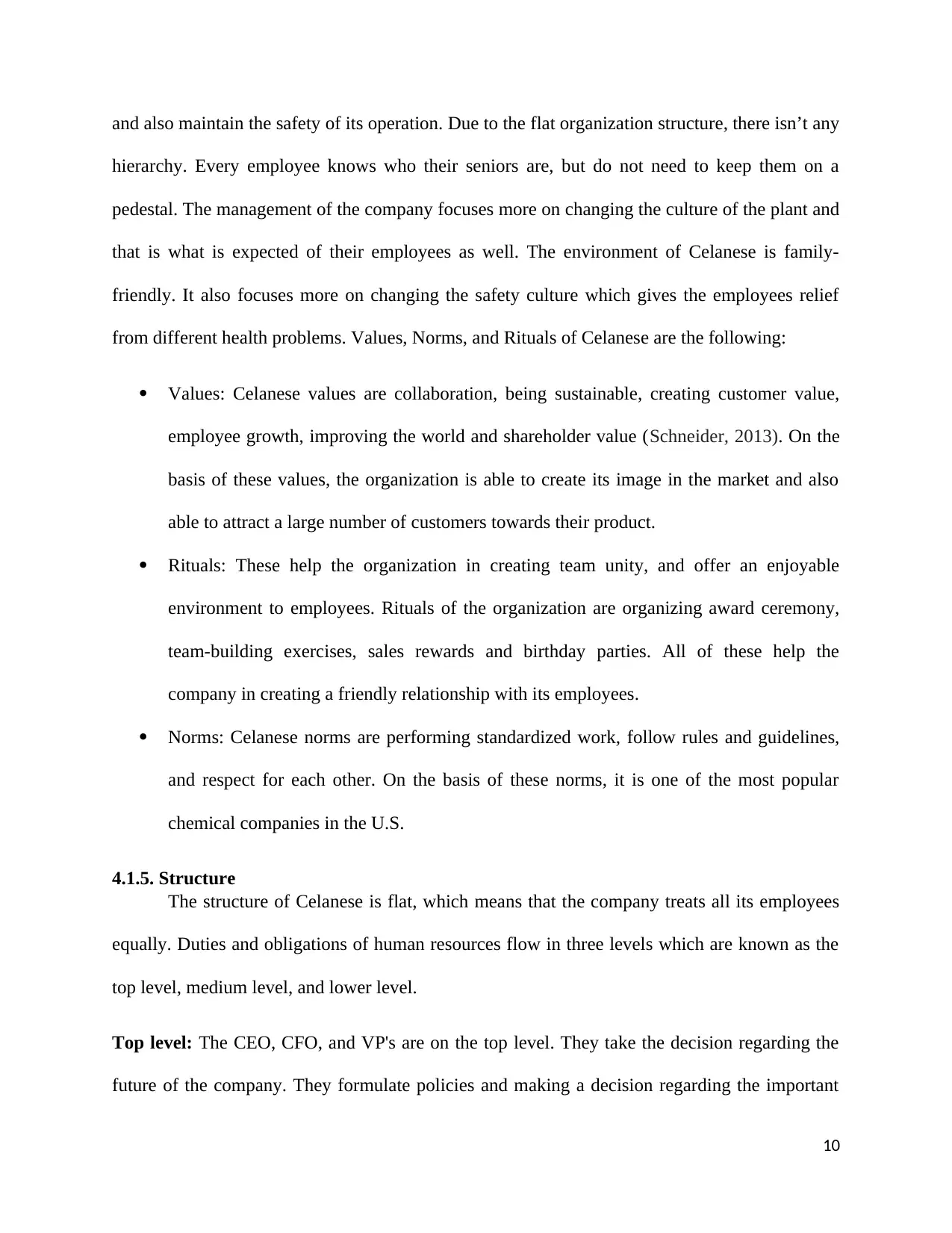
and also maintain the safety of its operation. Due to the flat organization structure, there isn’t any
hierarchy. Every employee knows who their seniors are, but do not need to keep them on a
pedestal. The management of the company focuses more on changing the culture of the plant and
that is what is expected of their employees as well. The environment of Celanese is family-
friendly. It also focuses more on changing the safety culture which gives the employees relief
from different health problems. Values, Norms, and Rituals of Celanese are the following:
Values: Celanese values are collaboration, being sustainable, creating customer value,
employee growth, improving the world and shareholder value (Schneider, 2013). On the
basis of these values, the organization is able to create its image in the market and also
able to attract a large number of customers towards their product.
Rituals: These help the organization in creating team unity, and offer an enjoyable
environment to employees. Rituals of the organization are organizing award ceremony,
team-building exercises, sales rewards and birthday parties. All of these help the
company in creating a friendly relationship with its employees.
Norms: Celanese norms are performing standardized work, follow rules and guidelines,
and respect for each other. On the basis of these norms, it is one of the most popular
chemical companies in the U.S.
4.1.5. Structure
The structure of Celanese is flat, which means that the company treats all its employees
equally. Duties and obligations of human resources flow in three levels which are known as the
top level, medium level, and lower level.
Top level: The CEO, CFO, and VP's are on the top level. They take the decision regarding the
future of the company. They formulate policies and making a decision regarding the important
10
hierarchy. Every employee knows who their seniors are, but do not need to keep them on a
pedestal. The management of the company focuses more on changing the culture of the plant and
that is what is expected of their employees as well. The environment of Celanese is family-
friendly. It also focuses more on changing the safety culture which gives the employees relief
from different health problems. Values, Norms, and Rituals of Celanese are the following:
Values: Celanese values are collaboration, being sustainable, creating customer value,
employee growth, improving the world and shareholder value (Schneider, 2013). On the
basis of these values, the organization is able to create its image in the market and also
able to attract a large number of customers towards their product.
Rituals: These help the organization in creating team unity, and offer an enjoyable
environment to employees. Rituals of the organization are organizing award ceremony,
team-building exercises, sales rewards and birthday parties. All of these help the
company in creating a friendly relationship with its employees.
Norms: Celanese norms are performing standardized work, follow rules and guidelines,
and respect for each other. On the basis of these norms, it is one of the most popular
chemical companies in the U.S.
4.1.5. Structure
The structure of Celanese is flat, which means that the company treats all its employees
equally. Duties and obligations of human resources flow in three levels which are known as the
top level, medium level, and lower level.
Top level: The CEO, CFO, and VP's are on the top level. They take the decision regarding the
future of the company. They formulate policies and making a decision regarding the important
10
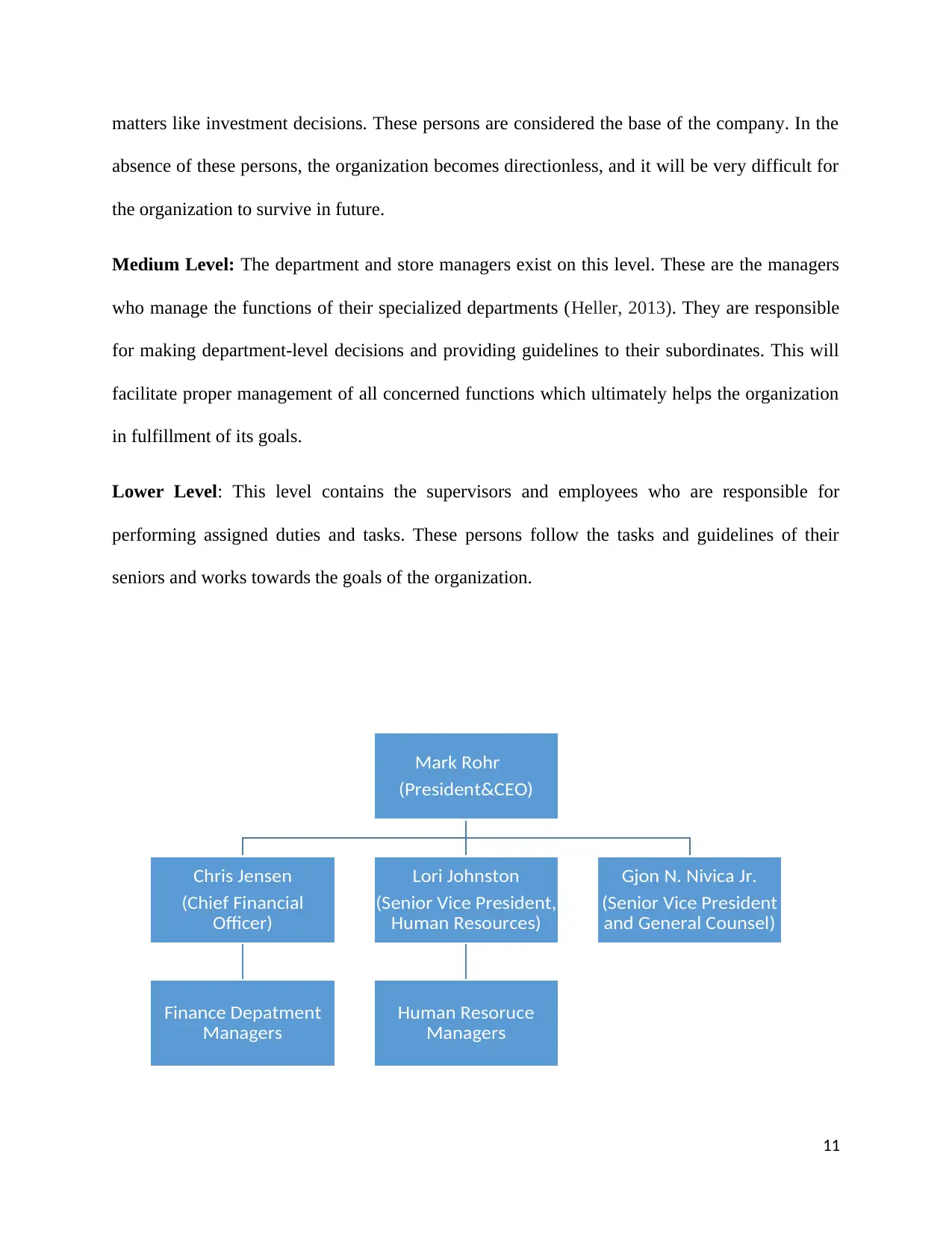
matters like investment decisions. These persons are considered the base of the company. In the
absence of these persons, the organization becomes directionless, and it will be very difficult for
the organization to survive in future.
Medium Level: The department and store managers exist on this level. These are the managers
who manage the functions of their specialized departments (Heller, 2013). They are responsible
for making department-level decisions and providing guidelines to their subordinates. This will
facilitate proper management of all concerned functions which ultimately helps the organization
in fulfillment of its goals.
Lower Level: This level contains the supervisors and employees who are responsible for
performing assigned duties and tasks. These persons follow the tasks and guidelines of their
seniors and works towards the goals of the organization.
11
Mark Rohr
(President&CEO)
Chris Jensen
(Chief Financial
Officer)
Finance Depatment
Managers
Lori Johnston
(Senior Vice President,
Human Resources)
Human Resoruce
Managers
Gjon N. Nivica Jr.
(Senior Vice President
and General Counsel)
absence of these persons, the organization becomes directionless, and it will be very difficult for
the organization to survive in future.
Medium Level: The department and store managers exist on this level. These are the managers
who manage the functions of their specialized departments (Heller, 2013). They are responsible
for making department-level decisions and providing guidelines to their subordinates. This will
facilitate proper management of all concerned functions which ultimately helps the organization
in fulfillment of its goals.
Lower Level: This level contains the supervisors and employees who are responsible for
performing assigned duties and tasks. These persons follow the tasks and guidelines of their
seniors and works towards the goals of the organization.
11
Mark Rohr
(President&CEO)
Chris Jensen
(Chief Financial
Officer)
Finance Depatment
Managers
Lori Johnston
(Senior Vice President,
Human Resources)
Human Resoruce
Managers
Gjon N. Nivica Jr.
(Senior Vice President
and General Counsel)
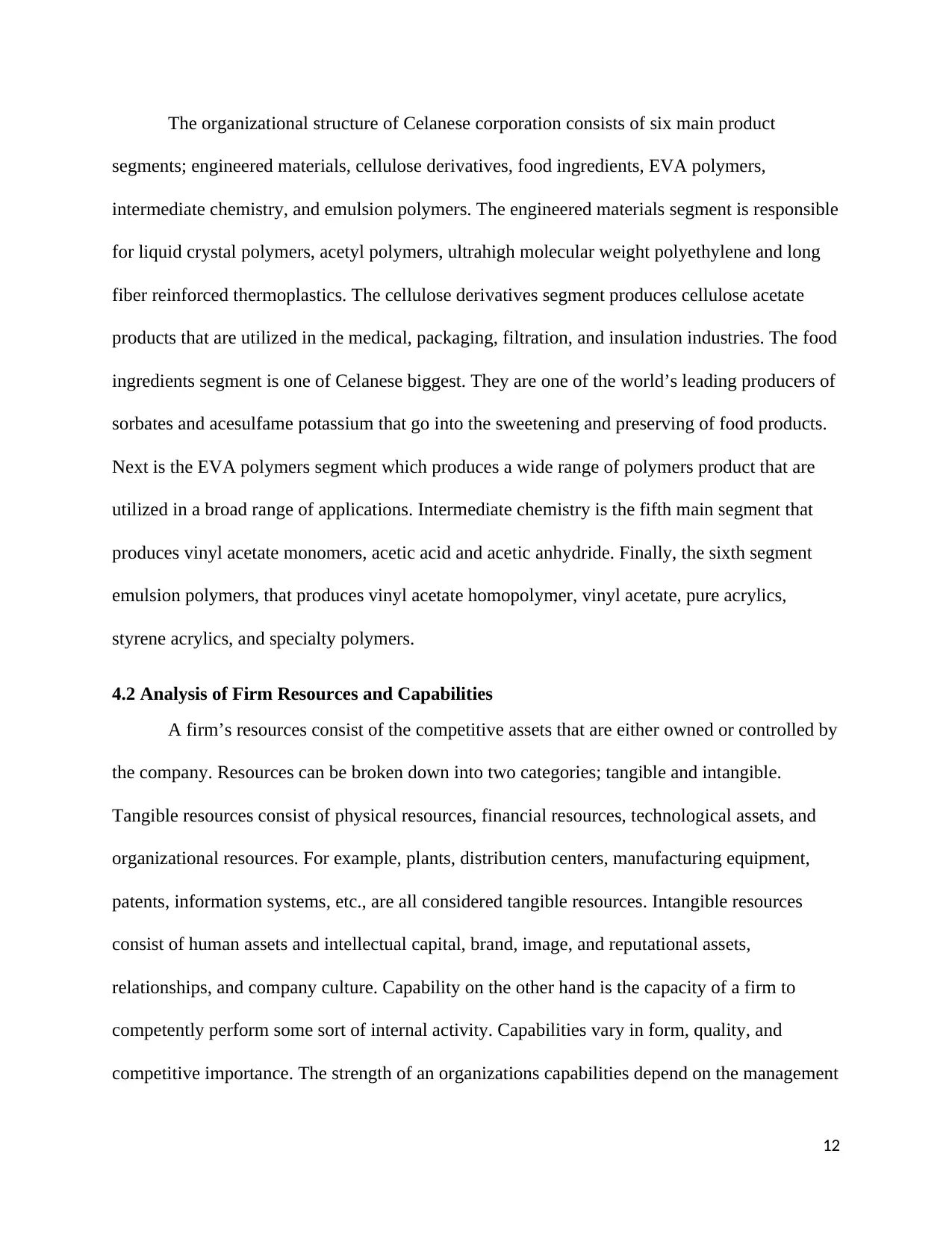
The organizational structure of Celanese corporation consists of six main product
segments; engineered materials, cellulose derivatives, food ingredients, EVA polymers,
intermediate chemistry, and emulsion polymers. The engineered materials segment is responsible
for liquid crystal polymers, acetyl polymers, ultrahigh molecular weight polyethylene and long
fiber reinforced thermoplastics. The cellulose derivatives segment produces cellulose acetate
products that are utilized in the medical, packaging, filtration, and insulation industries. The food
ingredients segment is one of Celanese biggest. They are one of the world’s leading producers of
sorbates and acesulfame potassium that go into the sweetening and preserving of food products.
Next is the EVA polymers segment which produces a wide range of polymers product that are
utilized in a broad range of applications. Intermediate chemistry is the fifth main segment that
produces vinyl acetate monomers, acetic acid and acetic anhydride. Finally, the sixth segment
emulsion polymers, that produces vinyl acetate homopolymer, vinyl acetate, pure acrylics,
styrene acrylics, and specialty polymers.
4.2 Analysis of Firm Resources and Capabilities
A firm’s resources consist of the competitive assets that are either owned or controlled by
the company. Resources can be broken down into two categories; tangible and intangible.
Tangible resources consist of physical resources, financial resources, technological assets, and
organizational resources. For example, plants, distribution centers, manufacturing equipment,
patents, information systems, etc., are all considered tangible resources. Intangible resources
consist of human assets and intellectual capital, brand, image, and reputational assets,
relationships, and company culture. Capability on the other hand is the capacity of a firm to
competently perform some sort of internal activity. Capabilities vary in form, quality, and
competitive importance. The strength of an organizations capabilities depend on the management
12
segments; engineered materials, cellulose derivatives, food ingredients, EVA polymers,
intermediate chemistry, and emulsion polymers. The engineered materials segment is responsible
for liquid crystal polymers, acetyl polymers, ultrahigh molecular weight polyethylene and long
fiber reinforced thermoplastics. The cellulose derivatives segment produces cellulose acetate
products that are utilized in the medical, packaging, filtration, and insulation industries. The food
ingredients segment is one of Celanese biggest. They are one of the world’s leading producers of
sorbates and acesulfame potassium that go into the sweetening and preserving of food products.
Next is the EVA polymers segment which produces a wide range of polymers product that are
utilized in a broad range of applications. Intermediate chemistry is the fifth main segment that
produces vinyl acetate monomers, acetic acid and acetic anhydride. Finally, the sixth segment
emulsion polymers, that produces vinyl acetate homopolymer, vinyl acetate, pure acrylics,
styrene acrylics, and specialty polymers.
4.2 Analysis of Firm Resources and Capabilities
A firm’s resources consist of the competitive assets that are either owned or controlled by
the company. Resources can be broken down into two categories; tangible and intangible.
Tangible resources consist of physical resources, financial resources, technological assets, and
organizational resources. For example, plants, distribution centers, manufacturing equipment,
patents, information systems, etc., are all considered tangible resources. Intangible resources
consist of human assets and intellectual capital, brand, image, and reputational assets,
relationships, and company culture. Capability on the other hand is the capacity of a firm to
competently perform some sort of internal activity. Capabilities vary in form, quality, and
competitive importance. The strength of an organizations capabilities depend on the management
12
Paraphrase This Document
Need a fresh take? Get an instant paraphrase of this document with our AI Paraphraser
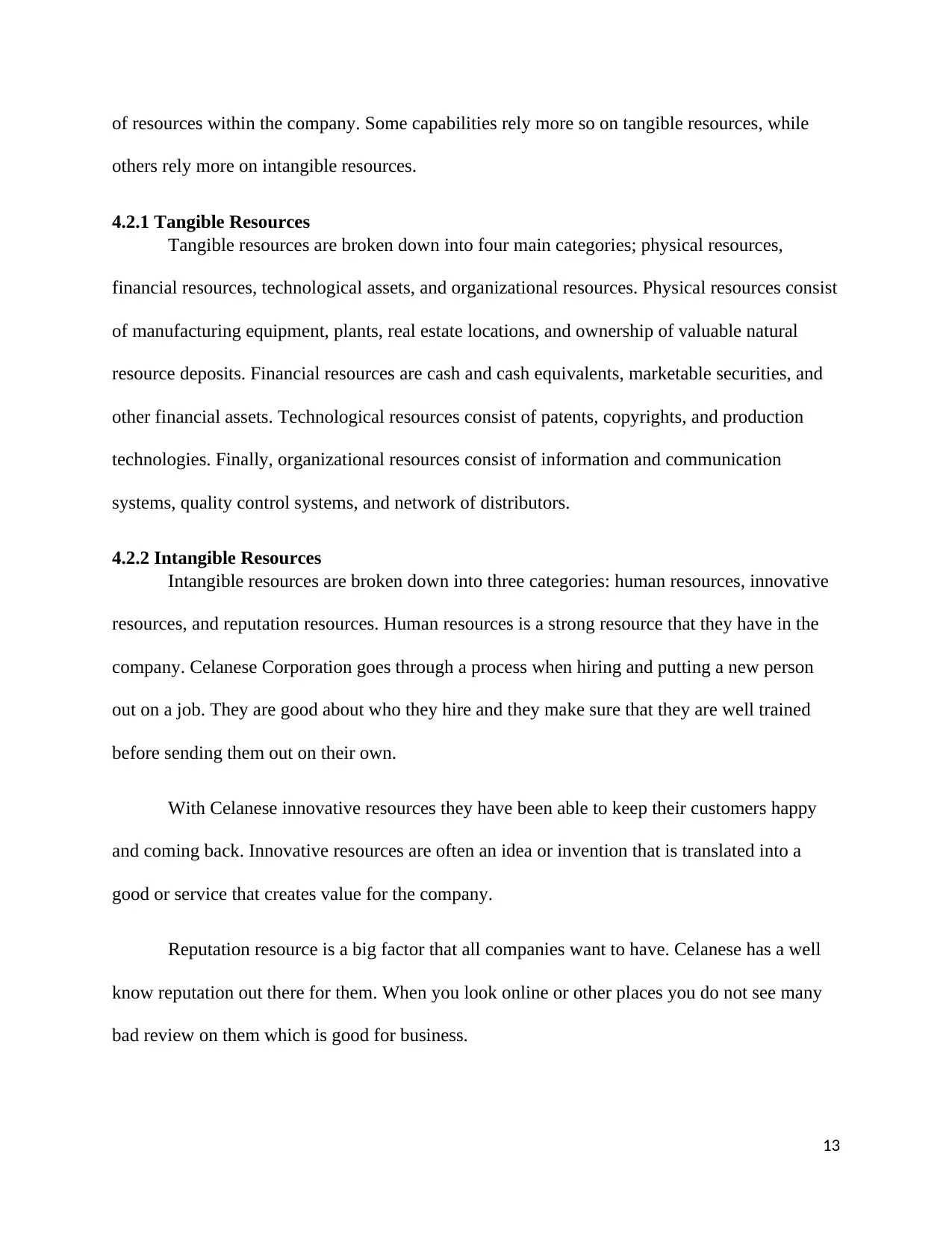
of resources within the company. Some capabilities rely more so on tangible resources, while
others rely more on intangible resources.
4.2.1 Tangible Resources
Tangible resources are broken down into four main categories; physical resources,
financial resources, technological assets, and organizational resources. Physical resources consist
of manufacturing equipment, plants, real estate locations, and ownership of valuable natural
resource deposits. Financial resources are cash and cash equivalents, marketable securities, and
other financial assets. Technological resources consist of patents, copyrights, and production
technologies. Finally, organizational resources consist of information and communication
systems, quality control systems, and network of distributors.
4.2.2 Intangible Resources
Intangible resources are broken down into three categories: human resources, innovative
resources, and reputation resources. Human resources is a strong resource that they have in the
company. Celanese Corporation goes through a process when hiring and putting a new person
out on a job. They are good about who they hire and they make sure that they are well trained
before sending them out on their own.
With Celanese innovative resources they have been able to keep their customers happy
and coming back. Innovative resources are often an idea or invention that is translated into a
good or service that creates value for the company.
Reputation resource is a big factor that all companies want to have. Celanese has a well
know reputation out there for them. When you look online or other places you do not see many
bad review on them which is good for business.
13
others rely more on intangible resources.
4.2.1 Tangible Resources
Tangible resources are broken down into four main categories; physical resources,
financial resources, technological assets, and organizational resources. Physical resources consist
of manufacturing equipment, plants, real estate locations, and ownership of valuable natural
resource deposits. Financial resources are cash and cash equivalents, marketable securities, and
other financial assets. Technological resources consist of patents, copyrights, and production
technologies. Finally, organizational resources consist of information and communication
systems, quality control systems, and network of distributors.
4.2.2 Intangible Resources
Intangible resources are broken down into three categories: human resources, innovative
resources, and reputation resources. Human resources is a strong resource that they have in the
company. Celanese Corporation goes through a process when hiring and putting a new person
out on a job. They are good about who they hire and they make sure that they are well trained
before sending them out on their own.
With Celanese innovative resources they have been able to keep their customers happy
and coming back. Innovative resources are often an idea or invention that is translated into a
good or service that creates value for the company.
Reputation resource is a big factor that all companies want to have. Celanese has a well
know reputation out there for them. When you look online or other places you do not see many
bad review on them which is good for business.
13
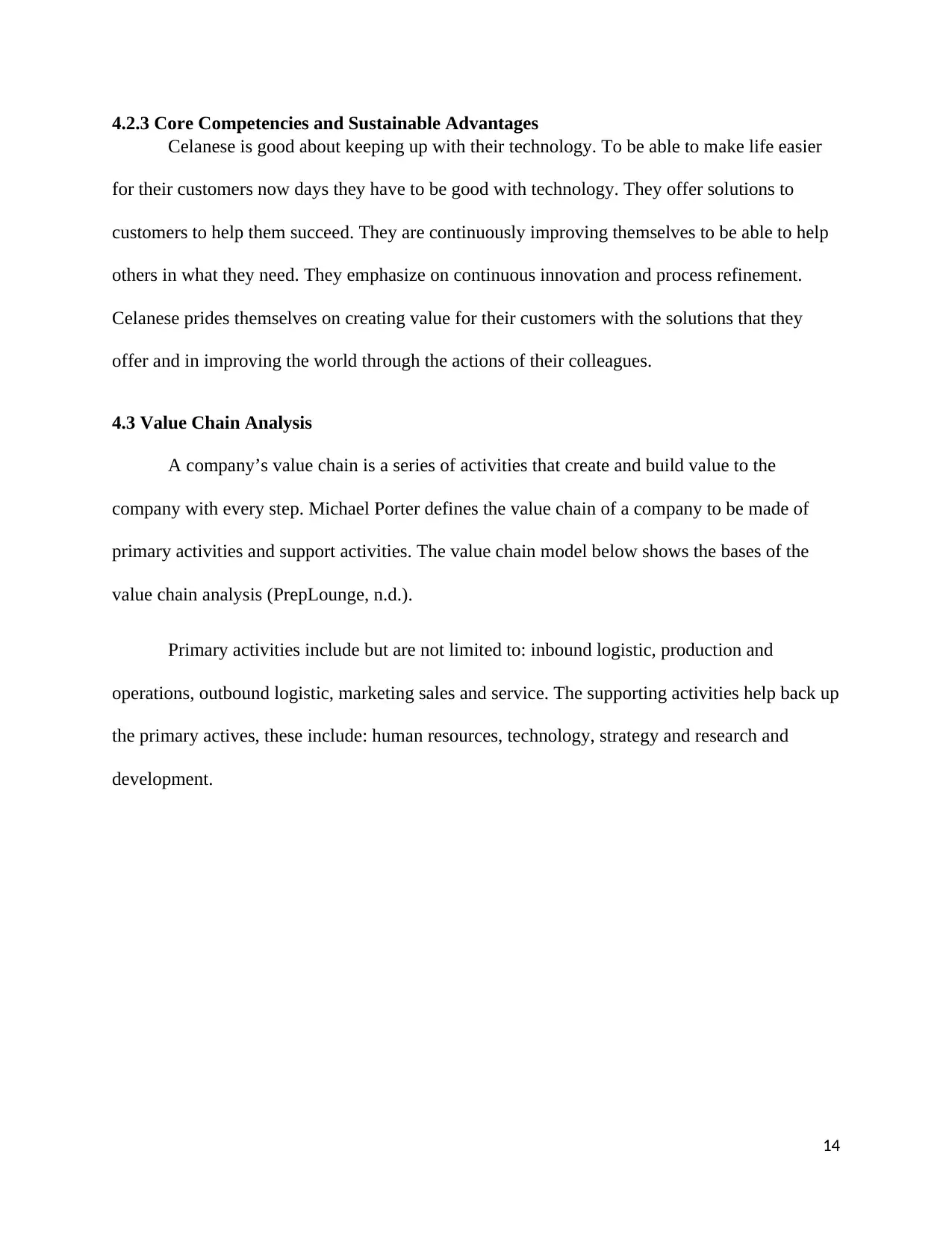
4.2.3 Core Competencies and Sustainable Advantages
Celanese is good about keeping up with their technology. To be able to make life easier
for their customers now days they have to be good with technology. They offer solutions to
customers to help them succeed. They are continuously improving themselves to be able to help
others in what they need. They emphasize on continuous innovation and process refinement.
Celanese prides themselves on creating value for their customers with the solutions that they
offer and in improving the world through the actions of their colleagues.
4.3 Value Chain Analysis
A company’s value chain is a series of activities that create and build value to the
company with every step. Michael Porter defines the value chain of a company to be made of
primary activities and support activities. The value chain model below shows the bases of the
value chain analysis (PrepLounge, n.d.).
Primary activities include but are not limited to: inbound logistic, production and
operations, outbound logistic, marketing sales and service. The supporting activities help back up
the primary actives, these include: human resources, technology, strategy and research and
development.
14
Celanese is good about keeping up with their technology. To be able to make life easier
for their customers now days they have to be good with technology. They offer solutions to
customers to help them succeed. They are continuously improving themselves to be able to help
others in what they need. They emphasize on continuous innovation and process refinement.
Celanese prides themselves on creating value for their customers with the solutions that they
offer and in improving the world through the actions of their colleagues.
4.3 Value Chain Analysis
A company’s value chain is a series of activities that create and build value to the
company with every step. Michael Porter defines the value chain of a company to be made of
primary activities and support activities. The value chain model below shows the bases of the
value chain analysis (PrepLounge, n.d.).
Primary activities include but are not limited to: inbound logistic, production and
operations, outbound logistic, marketing sales and service. The supporting activities help back up
the primary actives, these include: human resources, technology, strategy and research and
development.
14
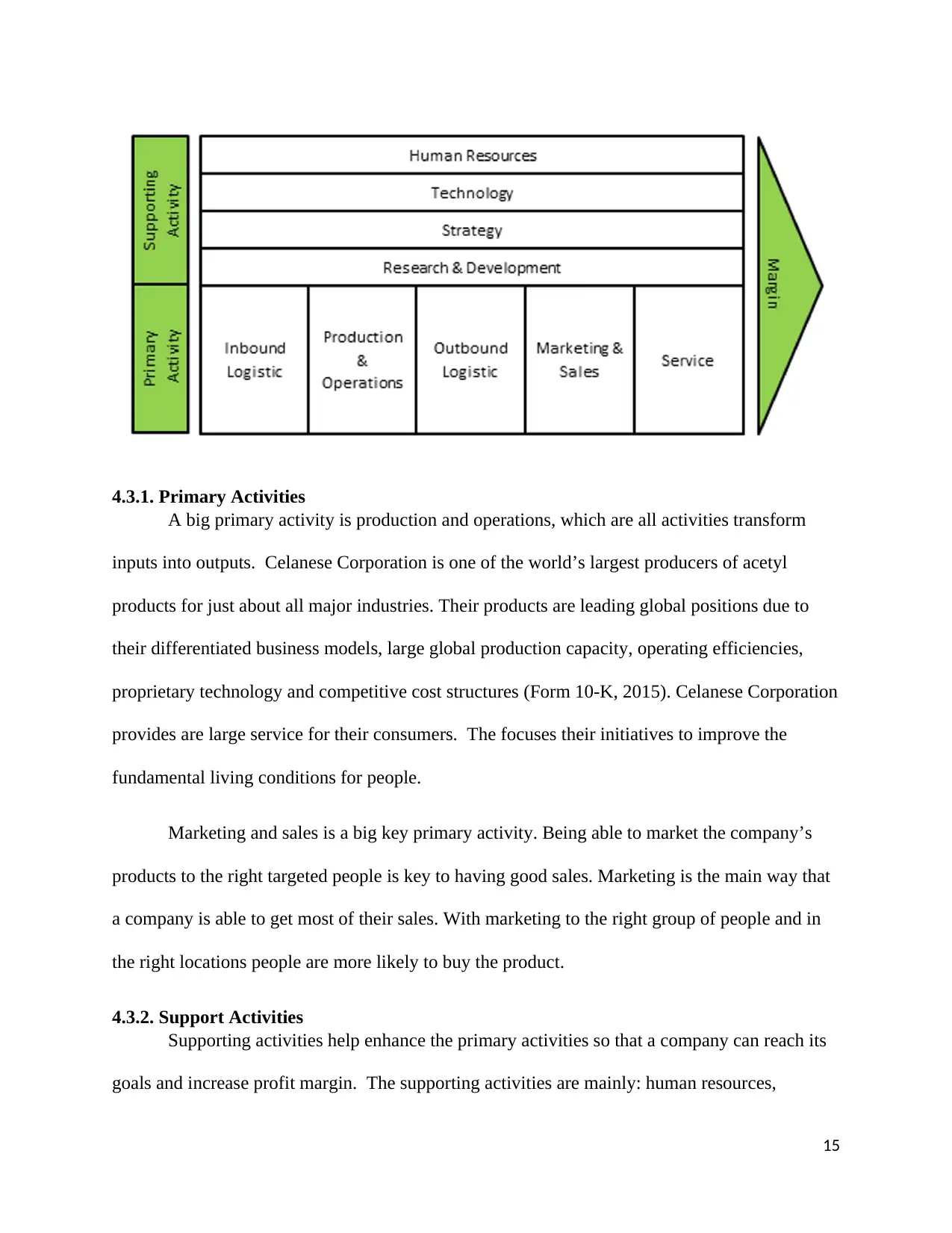
4.3.1. Primary Activities
A big primary activity is production and operations, which are all activities transform
inputs into outputs. Celanese Corporation is one of the world’s largest producers of acetyl
products for just about all major industries. Their products are leading global positions due to
their differentiated business models, large global production capacity, operating efficiencies,
proprietary technology and competitive cost structures (Form 10-K, 2015). Celanese Corporation
provides are large service for their consumers. The focuses their initiatives to improve the
fundamental living conditions for people.
Marketing and sales is a big key primary activity. Being able to market the company’s
products to the right targeted people is key to having good sales. Marketing is the main way that
a company is able to get most of their sales. With marketing to the right group of people and in
the right locations people are more likely to buy the product.
4.3.2. Support Activities
Supporting activities help enhance the primary activities so that a company can reach its
goals and increase profit margin. The supporting activities are mainly: human resources,
15
A big primary activity is production and operations, which are all activities transform
inputs into outputs. Celanese Corporation is one of the world’s largest producers of acetyl
products for just about all major industries. Their products are leading global positions due to
their differentiated business models, large global production capacity, operating efficiencies,
proprietary technology and competitive cost structures (Form 10-K, 2015). Celanese Corporation
provides are large service for their consumers. The focuses their initiatives to improve the
fundamental living conditions for people.
Marketing and sales is a big key primary activity. Being able to market the company’s
products to the right targeted people is key to having good sales. Marketing is the main way that
a company is able to get most of their sales. With marketing to the right group of people and in
the right locations people are more likely to buy the product.
4.3.2. Support Activities
Supporting activities help enhance the primary activities so that a company can reach its
goals and increase profit margin. The supporting activities are mainly: human resources,
15
Secure Best Marks with AI Grader
Need help grading? Try our AI Grader for instant feedback on your assignments.
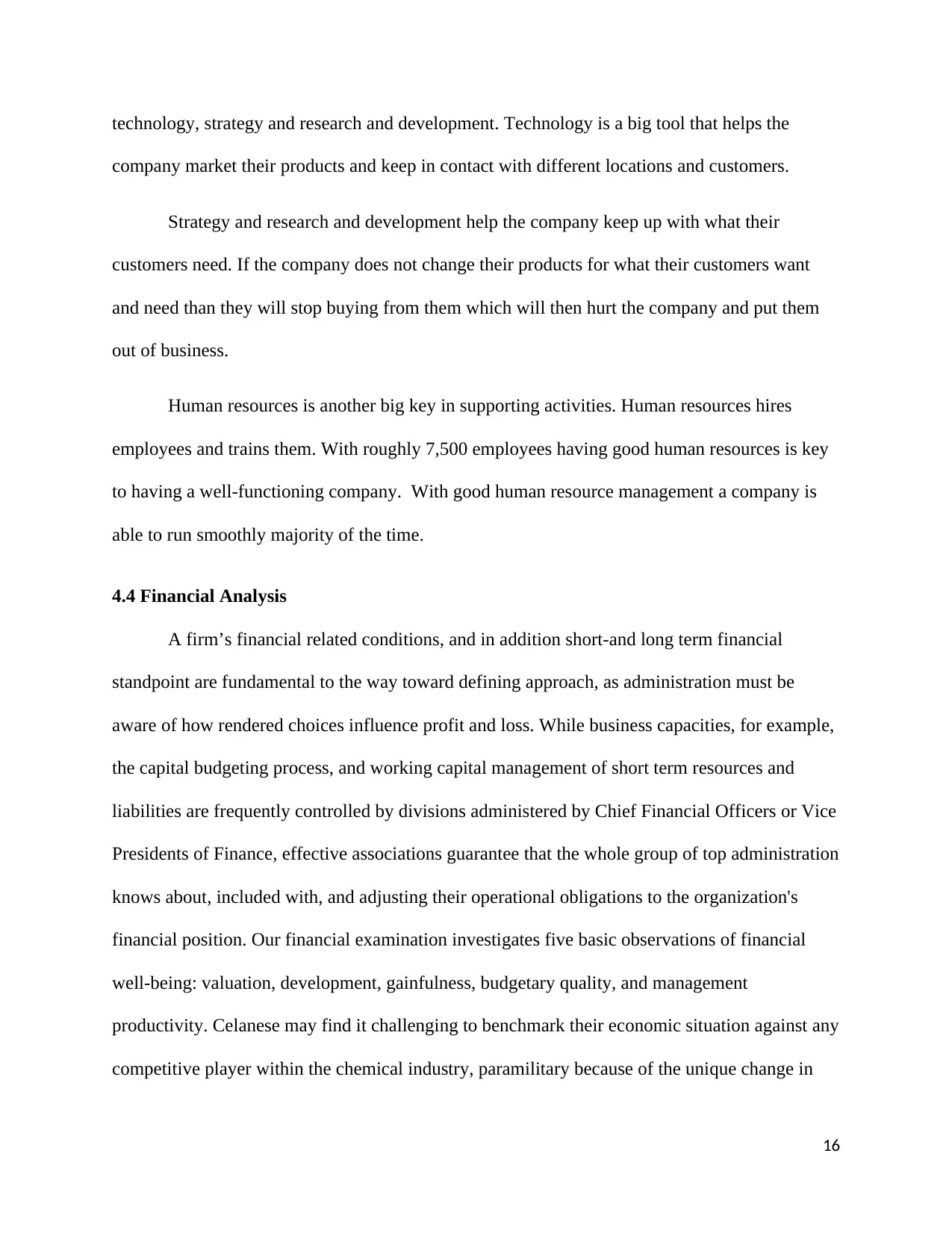
technology, strategy and research and development. Technology is a big tool that helps the
company market their products and keep in contact with different locations and customers.
Strategy and research and development help the company keep up with what their
customers need. If the company does not change their products for what their customers want
and need than they will stop buying from them which will then hurt the company and put them
out of business.
Human resources is another big key in supporting activities. Human resources hires
employees and trains them. With roughly 7,500 employees having good human resources is key
to having a well-functioning company. With good human resource management a company is
able to run smoothly majority of the time.
4.4 Financial Analysis
A firm’s financial related conditions, and in addition short-and long term financial
standpoint are fundamental to the way toward defining approach, as administration must be
aware of how rendered choices influence profit and loss. While business capacities, for example,
the capital budgeting process, and working capital management of short term resources and
liabilities are frequently controlled by divisions administered by Chief Financial Officers or Vice
Presidents of Finance, effective associations guarantee that the whole group of top administration
knows about, included with, and adjusting their operational obligations to the organization's
financial position. Our financial examination investigates five basic observations of financial
well-being: valuation, development, gainfulness, budgetary quality, and management
productivity. Celanese may find it challenging to benchmark their economic situation against any
competitive player within the chemical industry, paramilitary because of the unique change in
16
company market their products and keep in contact with different locations and customers.
Strategy and research and development help the company keep up with what their
customers need. If the company does not change their products for what their customers want
and need than they will stop buying from them which will then hurt the company and put them
out of business.
Human resources is another big key in supporting activities. Human resources hires
employees and trains them. With roughly 7,500 employees having good human resources is key
to having a well-functioning company. With good human resource management a company is
able to run smoothly majority of the time.
4.4 Financial Analysis
A firm’s financial related conditions, and in addition short-and long term financial
standpoint are fundamental to the way toward defining approach, as administration must be
aware of how rendered choices influence profit and loss. While business capacities, for example,
the capital budgeting process, and working capital management of short term resources and
liabilities are frequently controlled by divisions administered by Chief Financial Officers or Vice
Presidents of Finance, effective associations guarantee that the whole group of top administration
knows about, included with, and adjusting their operational obligations to the organization's
financial position. Our financial examination investigates five basic observations of financial
well-being: valuation, development, gainfulness, budgetary quality, and management
productivity. Celanese may find it challenging to benchmark their economic situation against any
competitive player within the chemical industry, paramilitary because of the unique change in
16
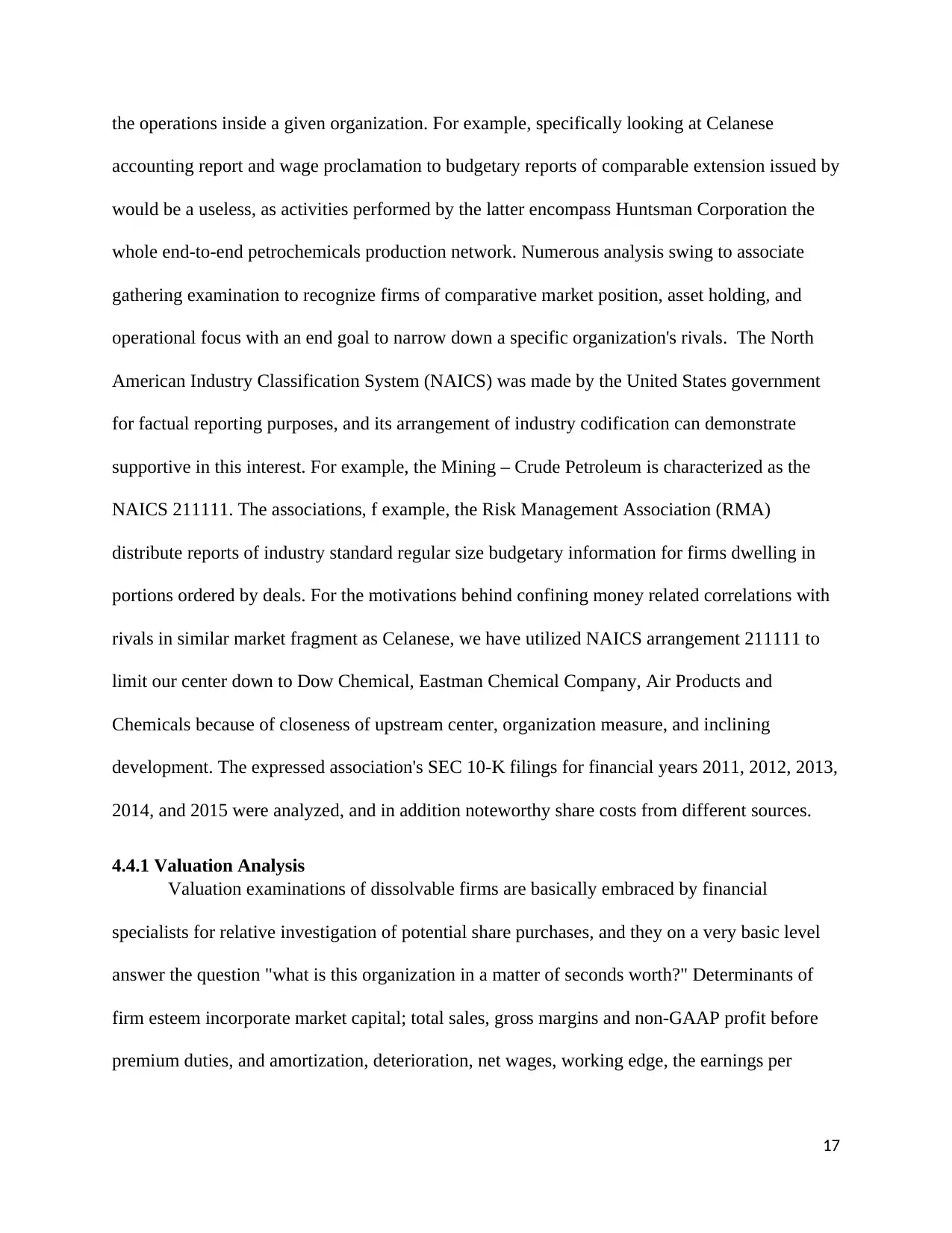
the operations inside a given organization. For example, specifically looking at Celanese
accounting report and wage proclamation to budgetary reports of comparable extension issued by
would be a useless, as activities performed by the latter encompass Huntsman Corporation the
whole end-to-end petrochemicals production network. Numerous analysis swing to associate
gathering examination to recognize firms of comparative market position, asset holding, and
operational focus with an end goal to narrow down a specific organization's rivals. The North
American Industry Classification System (NAICS) was made by the United States government
for factual reporting purposes, and its arrangement of industry codification can demonstrate
supportive in this interest. For example, the Mining – Crude Petroleum is characterized as the
NAICS 211111. The associations, f example, the Risk Management Association (RMA)
distribute reports of industry standard regular size budgetary information for firms dwelling in
portions ordered by deals. For the motivations behind confining money related correlations with
rivals in similar market fragment as Celanese, we have utilized NAICS arrangement 211111 to
limit our center down to Dow Chemical, Eastman Chemical Company, Air Products and
Chemicals because of closeness of upstream center, organization measure, and inclining
development. The expressed association's SEC 10-K filings for financial years 2011, 2012, 2013,
2014, and 2015 were analyzed, and in addition noteworthy share costs from different sources.
4.4.1 Valuation Analysis
Valuation examinations of dissolvable firms are basically embraced by financial
specialists for relative investigation of potential share purchases, and they on a very basic level
answer the question "what is this organization in a matter of seconds worth?" Determinants of
firm esteem incorporate market capital; total sales, gross margins and non-GAAP profit before
premium duties, and amortization, deterioration, net wages, working edge, the earnings per
17
accounting report and wage proclamation to budgetary reports of comparable extension issued by
would be a useless, as activities performed by the latter encompass Huntsman Corporation the
whole end-to-end petrochemicals production network. Numerous analysis swing to associate
gathering examination to recognize firms of comparative market position, asset holding, and
operational focus with an end goal to narrow down a specific organization's rivals. The North
American Industry Classification System (NAICS) was made by the United States government
for factual reporting purposes, and its arrangement of industry codification can demonstrate
supportive in this interest. For example, the Mining – Crude Petroleum is characterized as the
NAICS 211111. The associations, f example, the Risk Management Association (RMA)
distribute reports of industry standard regular size budgetary information for firms dwelling in
portions ordered by deals. For the motivations behind confining money related correlations with
rivals in similar market fragment as Celanese, we have utilized NAICS arrangement 211111 to
limit our center down to Dow Chemical, Eastman Chemical Company, Air Products and
Chemicals because of closeness of upstream center, organization measure, and inclining
development. The expressed association's SEC 10-K filings for financial years 2011, 2012, 2013,
2014, and 2015 were analyzed, and in addition noteworthy share costs from different sources.
4.4.1 Valuation Analysis
Valuation examinations of dissolvable firms are basically embraced by financial
specialists for relative investigation of potential share purchases, and they on a very basic level
answer the question "what is this organization in a matter of seconds worth?" Determinants of
firm esteem incorporate market capital; total sales, gross margins and non-GAAP profit before
premium duties, and amortization, deterioration, net wages, working edge, the earnings per
17
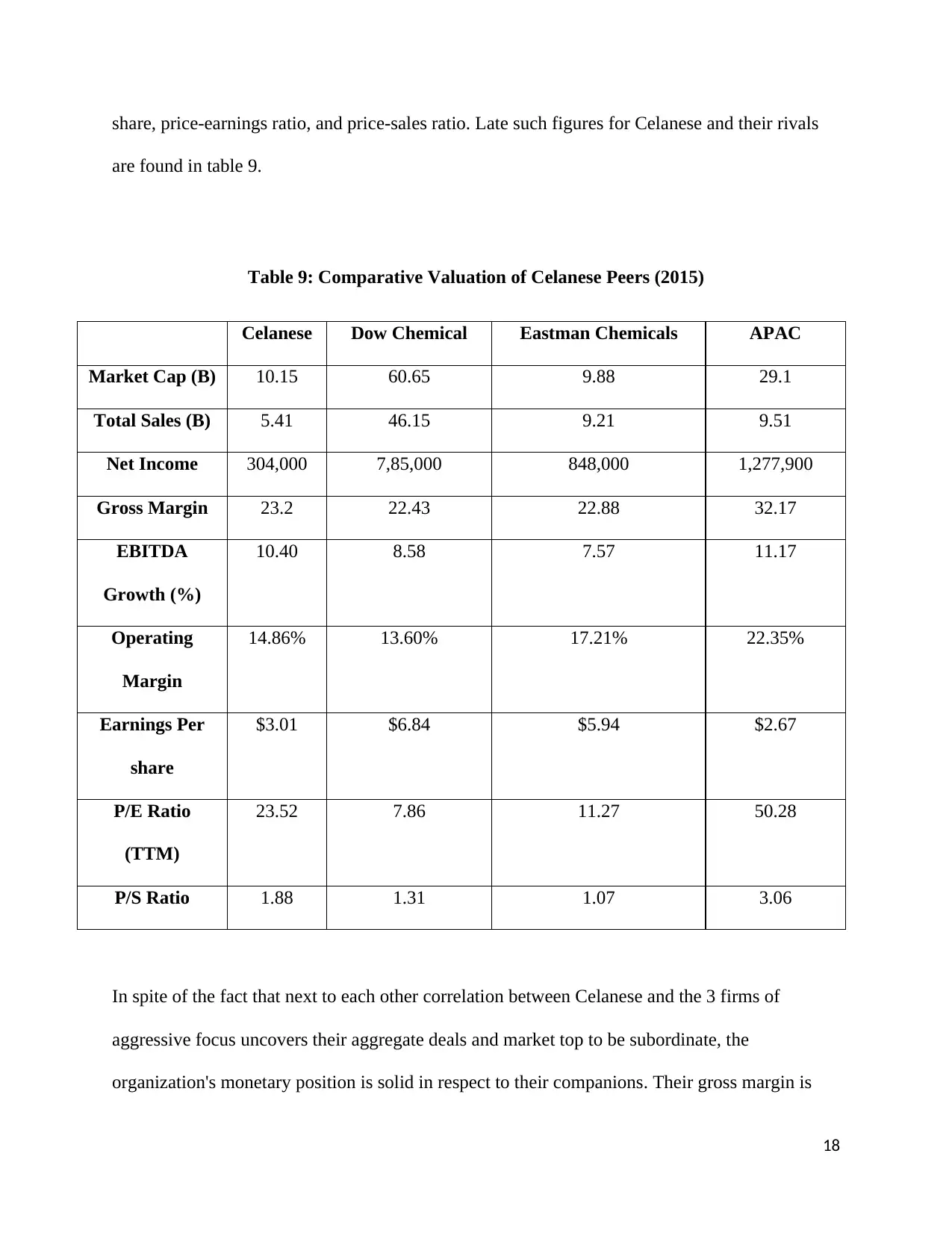
share, price-earnings ratio, and price-sales ratio. Late such figures for Celanese and their rivals
are found in table 9.
Table 9: Comparative Valuation of Celanese Peers (2015)
Celanese Dow Chemical Eastman Chemicals APAC
Market Cap (B) 10.15 60.65 9.88 29.1
Total Sales (B) 5.41 46.15 9.21 9.51
Net Income 304,000 7,85,000 848,000 1,277,900
Gross Margin 23.2 22.43 22.88 32.17
EBITDA
Growth (%)
10.40 8.58 7.57 11.17
Operating
Margin
14.86% 13.60% 17.21% 22.35%
Earnings Per
share
$3.01 $6.84 $5.94 $2.67
P/E Ratio
(TTM)
23.52 7.86 11.27 50.28
P/S Ratio 1.88 1.31 1.07 3.06
In spite of the fact that next to each other correlation between Celanese and the 3 firms of
aggressive focus uncovers their aggregate deals and market top to be subordinate, the
organization's monetary position is solid in respect to their companions. Their gross margin is
18
are found in table 9.
Table 9: Comparative Valuation of Celanese Peers (2015)
Celanese Dow Chemical Eastman Chemicals APAC
Market Cap (B) 10.15 60.65 9.88 29.1
Total Sales (B) 5.41 46.15 9.21 9.51
Net Income 304,000 7,85,000 848,000 1,277,900
Gross Margin 23.2 22.43 22.88 32.17
EBITDA
Growth (%)
10.40 8.58 7.57 11.17
Operating
Margin
14.86% 13.60% 17.21% 22.35%
Earnings Per
share
$3.01 $6.84 $5.94 $2.67
P/E Ratio
(TTM)
23.52 7.86 11.27 50.28
P/S Ratio 1.88 1.31 1.07 3.06
In spite of the fact that next to each other correlation between Celanese and the 3 firms of
aggressive focus uncovers their aggregate deals and market top to be subordinate, the
organization's monetary position is solid in respect to their companions. Their gross margin is
18
Paraphrase This Document
Need a fresh take? Get an instant paraphrase of this document with our AI Paraphraser
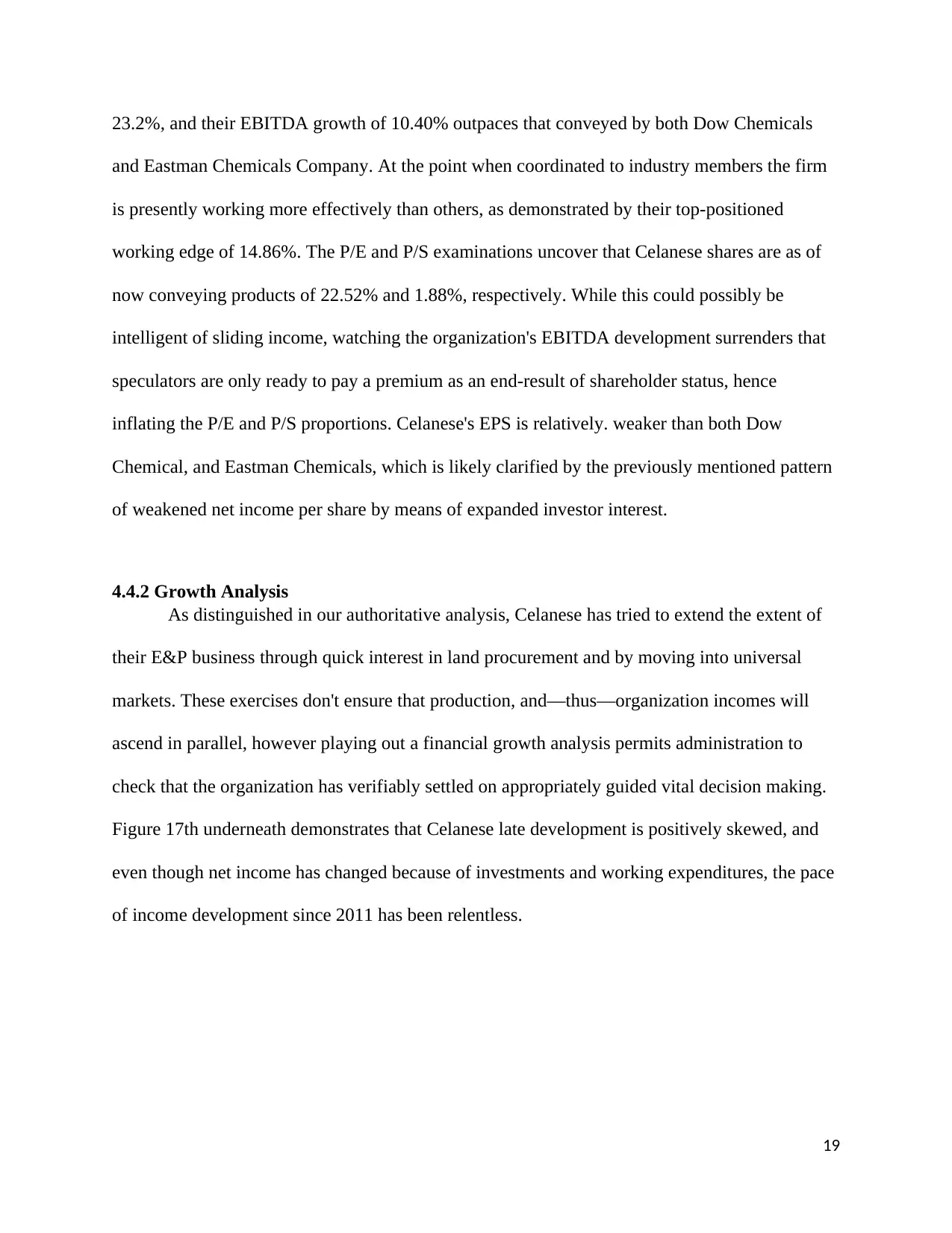
23.2%, and their EBITDA growth of 10.40% outpaces that conveyed by both Dow Chemicals
and Eastman Chemicals Company. At the point when coordinated to industry members the firm
is presently working more effectively than others, as demonstrated by their top-positioned
working edge of 14.86%. The P/E and P/S examinations uncover that Celanese shares are as of
now conveying products of 22.52% and 1.88%, respectively. While this could possibly be
intelligent of sliding income, watching the organization's EBITDA development surrenders that
speculators are only ready to pay a premium as an end-result of shareholder status, hence
inflating the P/E and P/S proportions. Celanese's EPS is relatively. weaker than both Dow
Chemical, and Eastman Chemicals, which is likely clarified by the previously mentioned pattern
of weakened net income per share by means of expanded investor interest.
4.4.2 Growth Analysis
As distinguished in our authoritative analysis, Celanese has tried to extend the extent of
their E&P business through quick interest in land procurement and by moving into universal
markets. These exercises don't ensure that production, and—thus—organization incomes will
ascend in parallel, however playing out a financial growth analysis permits administration to
check that the organization has verifiably settled on appropriately guided vital decision making.
Figure 17th underneath demonstrates that Celanese late development is positively skewed, and
even though net income has changed because of investments and working expenditures, the pace
of income development since 2011 has been relentless.
19
and Eastman Chemicals Company. At the point when coordinated to industry members the firm
is presently working more effectively than others, as demonstrated by their top-positioned
working edge of 14.86%. The P/E and P/S examinations uncover that Celanese shares are as of
now conveying products of 22.52% and 1.88%, respectively. While this could possibly be
intelligent of sliding income, watching the organization's EBITDA development surrenders that
speculators are only ready to pay a premium as an end-result of shareholder status, hence
inflating the P/E and P/S proportions. Celanese's EPS is relatively. weaker than both Dow
Chemical, and Eastman Chemicals, which is likely clarified by the previously mentioned pattern
of weakened net income per share by means of expanded investor interest.
4.4.2 Growth Analysis
As distinguished in our authoritative analysis, Celanese has tried to extend the extent of
their E&P business through quick interest in land procurement and by moving into universal
markets. These exercises don't ensure that production, and—thus—organization incomes will
ascend in parallel, however playing out a financial growth analysis permits administration to
check that the organization has verifiably settled on appropriately guided vital decision making.
Figure 17th underneath demonstrates that Celanese late development is positively skewed, and
even though net income has changed because of investments and working expenditures, the pace
of income development since 2011 has been relentless.
19
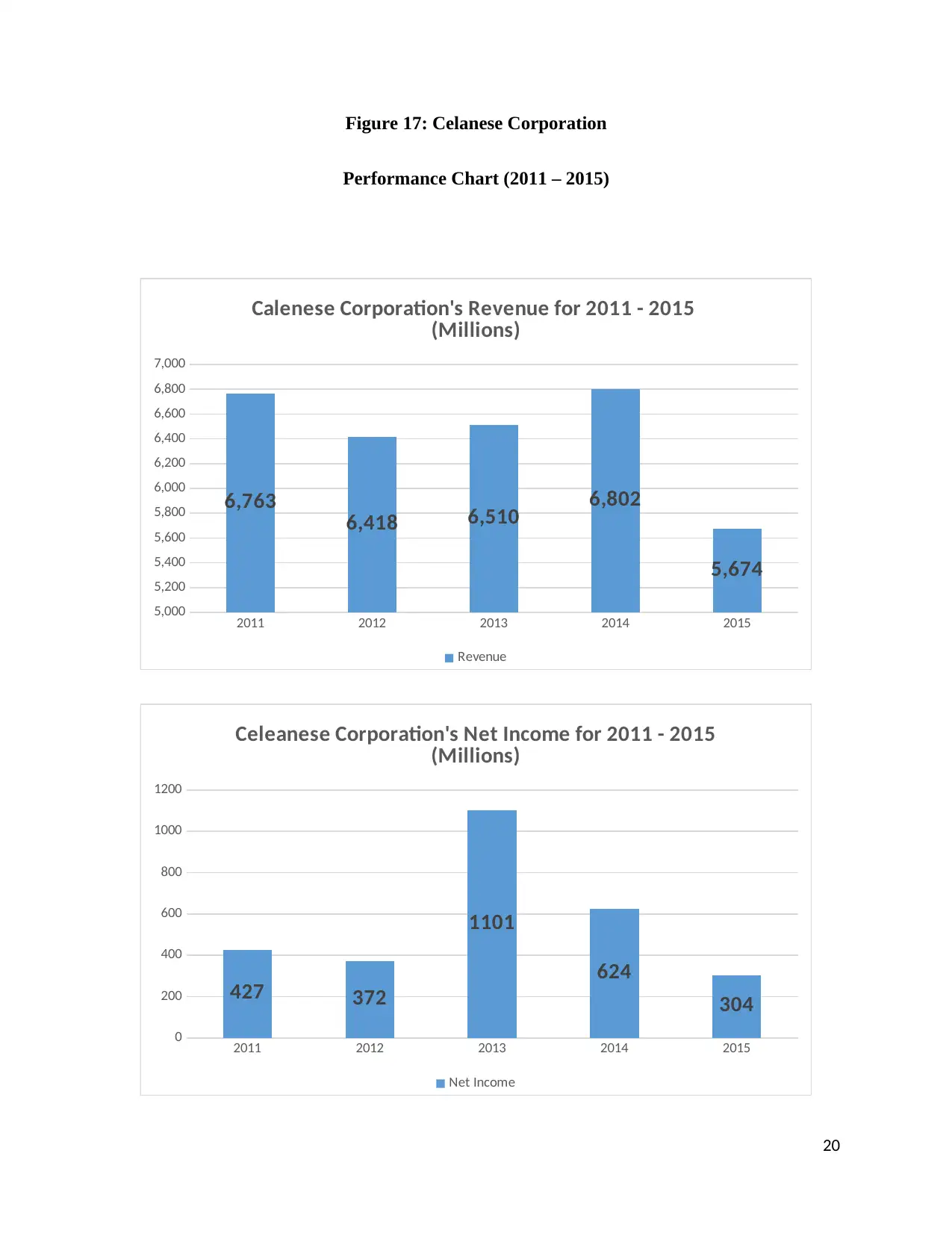
Figure 17: Celanese Corporation
Performance Chart (2011 – 2015)
2011 2012 2013 2014 2015
5,000
5,200
5,400
5,600
5,800
6,000
6,200
6,400
6,600
6,800
7,000
6,763 6,418 6,510 6,802
5,674
Calenese Corporation's Revenue for 2011 - 2015
(Millions)
Revenue
2011 2012 2013 2014 2015
0
200
400
600
800
1000
1200
427 372
1101
624
304
Celeanese Corporation's Net Income for 2011 - 2015
(Millions)
Net Income
20
Performance Chart (2011 – 2015)
2011 2012 2013 2014 2015
5,000
5,200
5,400
5,600
5,800
6,000
6,200
6,400
6,600
6,800
7,000
6,763 6,418 6,510 6,802
5,674
Calenese Corporation's Revenue for 2011 - 2015
(Millions)
Revenue
2011 2012 2013 2014 2015
0
200
400
600
800
1000
1200
427 372
1101
624
304
Celeanese Corporation's Net Income for 2011 - 2015
(Millions)
Net Income
20
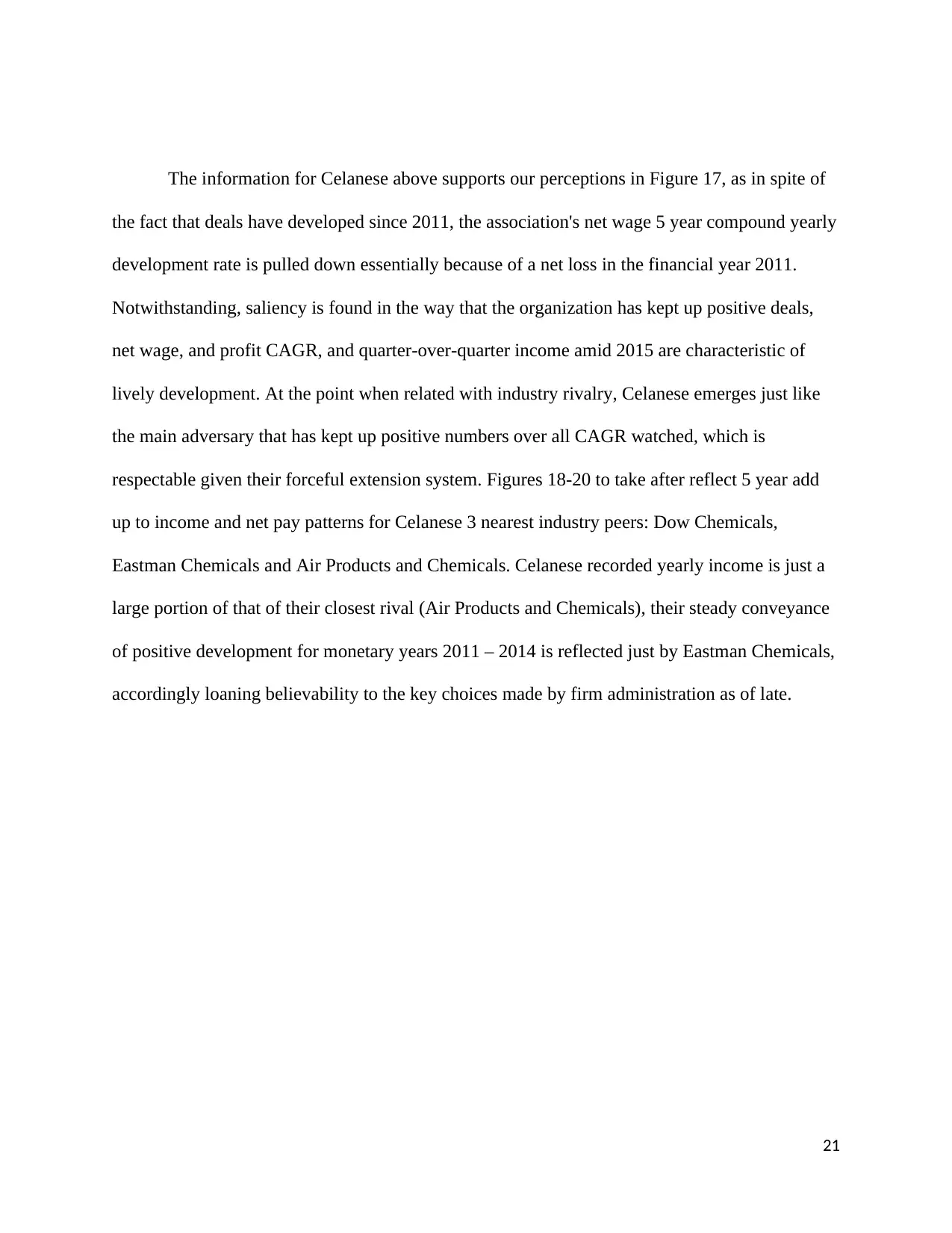
The information for Celanese above supports our perceptions in Figure 17, as in spite of
the fact that deals have developed since 2011, the association's net wage 5 year compound yearly
development rate is pulled down essentially because of a net loss in the financial year 2011.
Notwithstanding, saliency is found in the way that the organization has kept up positive deals,
net wage, and profit CAGR, and quarter-over-quarter income amid 2015 are characteristic of
lively development. At the point when related with industry rivalry, Celanese emerges just like
the main adversary that has kept up positive numbers over all CAGR watched, which is
respectable given their forceful extension system. Figures 18-20 to take after reflect 5 year add
up to income and net pay patterns for Celanese 3 nearest industry peers: Dow Chemicals,
Eastman Chemicals and Air Products and Chemicals. Celanese recorded yearly income is just a
large portion of that of their closest rival (Air Products and Chemicals), their steady conveyance
of positive development for monetary years 2011 – 2014 is reflected just by Eastman Chemicals,
accordingly loaning believability to the key choices made by firm administration as of late.
21
the fact that deals have developed since 2011, the association's net wage 5 year compound yearly
development rate is pulled down essentially because of a net loss in the financial year 2011.
Notwithstanding, saliency is found in the way that the organization has kept up positive deals,
net wage, and profit CAGR, and quarter-over-quarter income amid 2015 are characteristic of
lively development. At the point when related with industry rivalry, Celanese emerges just like
the main adversary that has kept up positive numbers over all CAGR watched, which is
respectable given their forceful extension system. Figures 18-20 to take after reflect 5 year add
up to income and net pay patterns for Celanese 3 nearest industry peers: Dow Chemicals,
Eastman Chemicals and Air Products and Chemicals. Celanese recorded yearly income is just a
large portion of that of their closest rival (Air Products and Chemicals), their steady conveyance
of positive development for monetary years 2011 – 2014 is reflected just by Eastman Chemicals,
accordingly loaning believability to the key choices made by firm administration as of late.
21
Secure Best Marks with AI Grader
Need help grading? Try our AI Grader for instant feedback on your assignments.
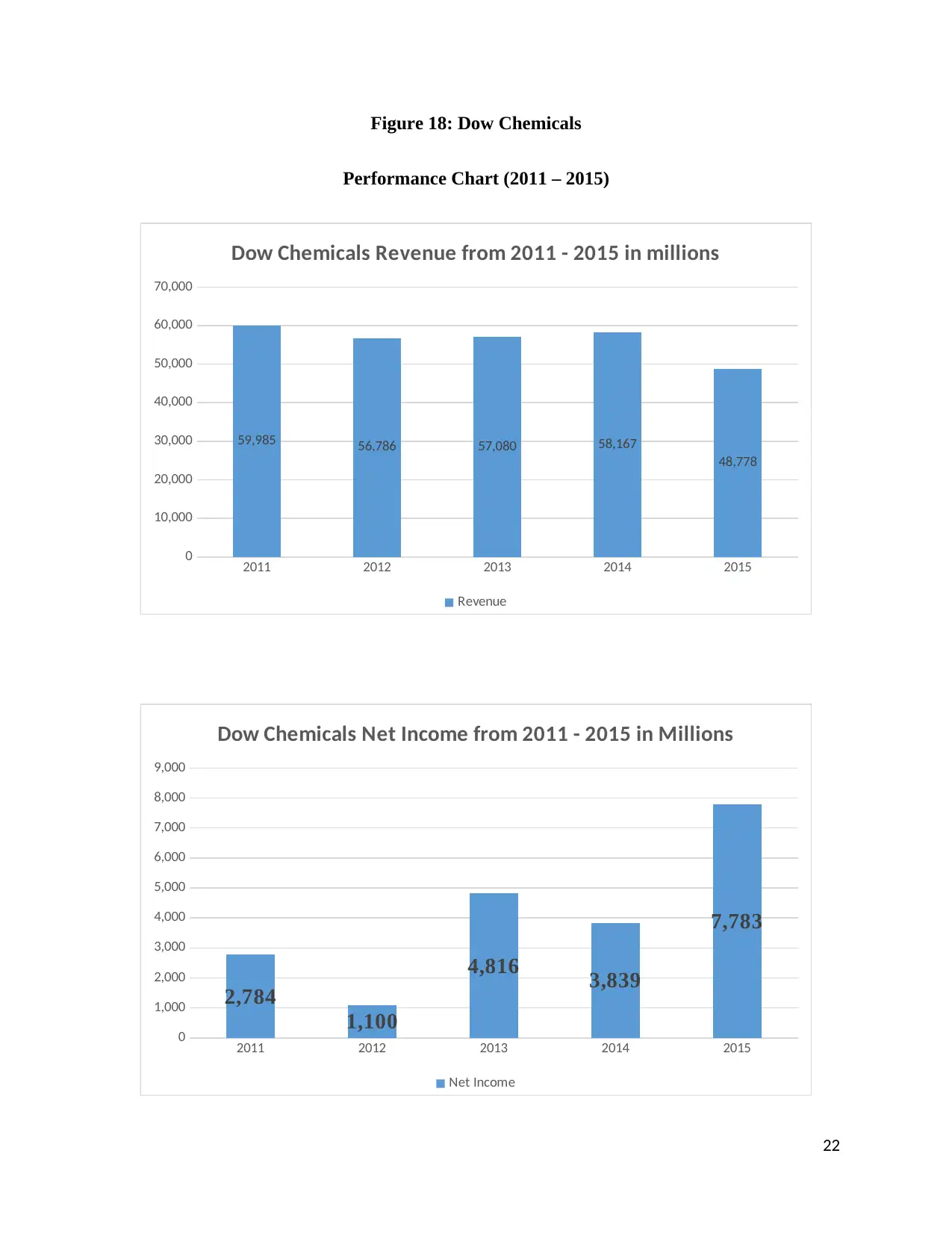
Figure 18: Dow Chemicals
Performance Chart (2011 – 2015)
2011 2012 2013 2014 2015
0
10,000
20,000
30,000
40,000
50,000
60,000
70,000
59,985 56,786 57,080 58,167
48,778
Dow Chemicals Revenue from 2011 - 2015 in millions
Revenue
2011 2012 2013 2014 2015
0
1,000
2,000
3,000
4,000
5,000
6,000
7,000
8,000
9,000
2,784
1,100
4,816 3,839
7,783
Dow Chemicals Net Income from 2011 - 2015 in Millions
Net Income
22
Performance Chart (2011 – 2015)
2011 2012 2013 2014 2015
0
10,000
20,000
30,000
40,000
50,000
60,000
70,000
59,985 56,786 57,080 58,167
48,778
Dow Chemicals Revenue from 2011 - 2015 in millions
Revenue
2011 2012 2013 2014 2015
0
1,000
2,000
3,000
4,000
5,000
6,000
7,000
8,000
9,000
2,784
1,100
4,816 3,839
7,783
Dow Chemicals Net Income from 2011 - 2015 in Millions
Net Income
22
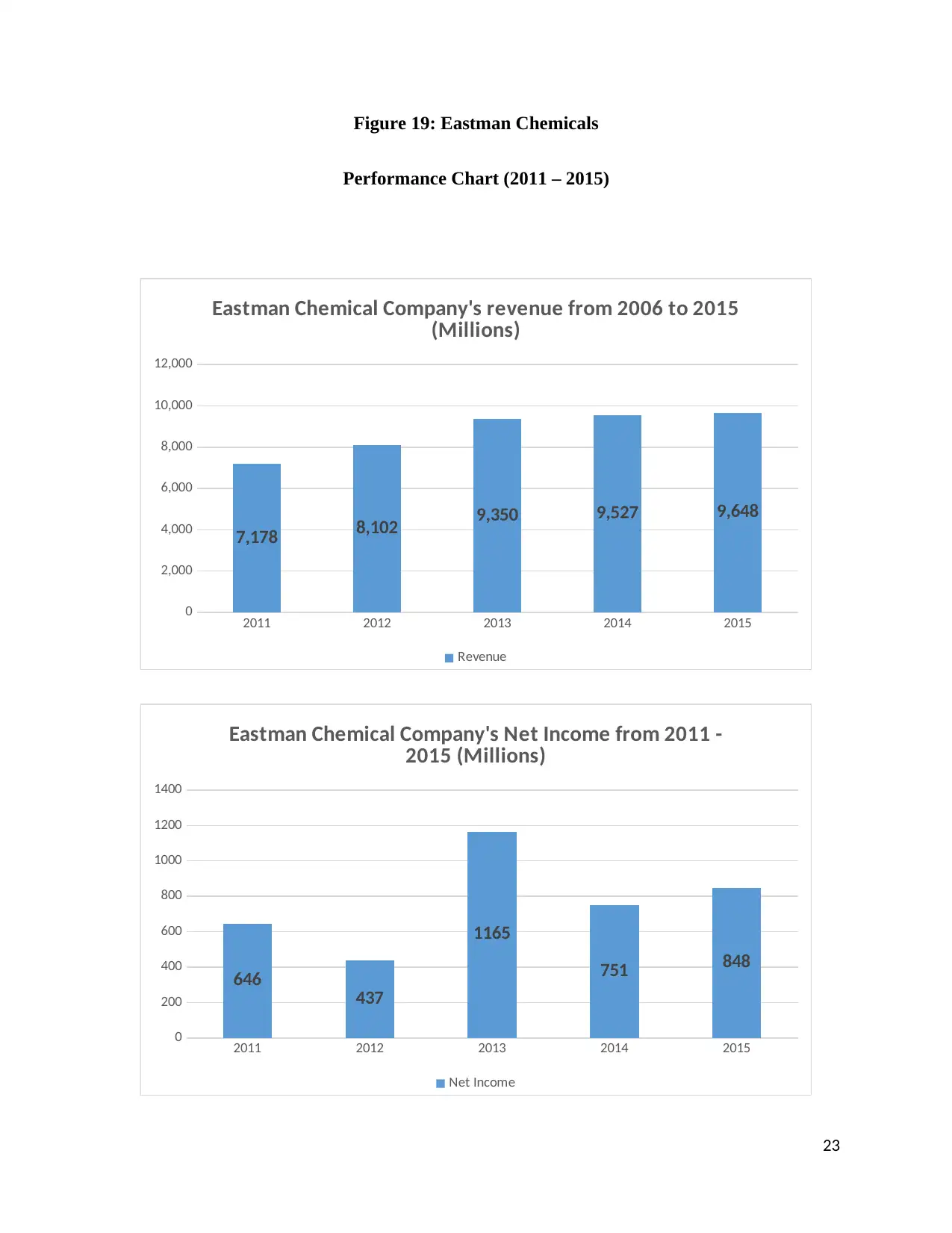
Figure 19: Eastman Chemicals
Performance Chart (2011 – 2015)
2011 2012 2013 2014 2015
0
2,000
4,000
6,000
8,000
10,000
12,000
7,178 8,102 9,350 9,527 9,648
Eastman Chemical Company's revenue from 2006 to 2015
(Millions)
Revenue
2011 2012 2013 2014 2015
0
200
400
600
800
1000
1200
1400
646 437
1165
751 848
Eastman Chemical Company's Net Income from 2011 -
2015 (Millions)
Net Income
23
Performance Chart (2011 – 2015)
2011 2012 2013 2014 2015
0
2,000
4,000
6,000
8,000
10,000
12,000
7,178 8,102 9,350 9,527 9,648
Eastman Chemical Company's revenue from 2006 to 2015
(Millions)
Revenue
2011 2012 2013 2014 2015
0
200
400
600
800
1000
1200
1400
646 437
1165
751 848
Eastman Chemical Company's Net Income from 2011 -
2015 (Millions)
Net Income
23
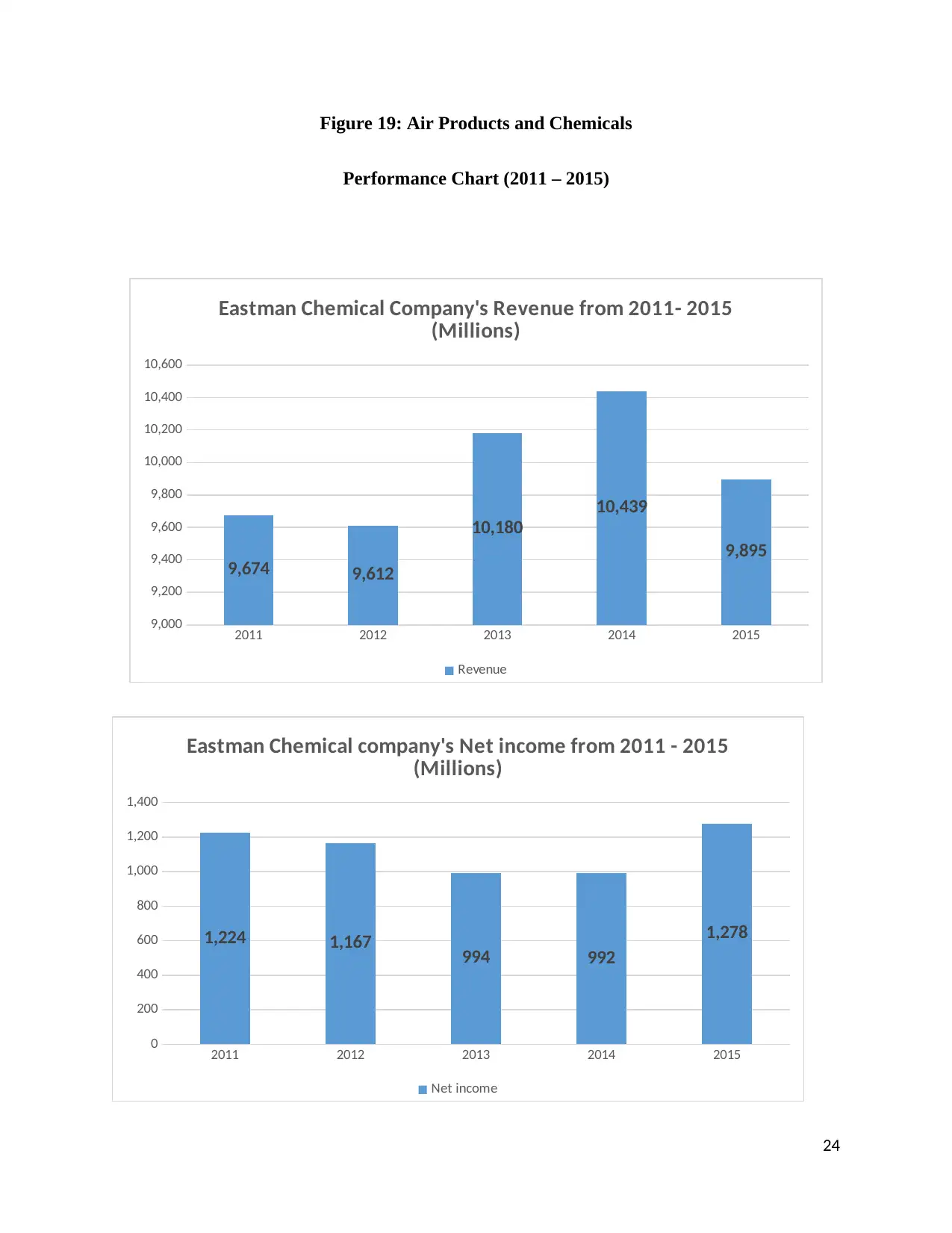
Figure 19: Air Products and Chemicals
Performance Chart (2011 – 2015)
2011 2012 2013 2014 2015
9,000
9,200
9,400
9,600
9,800
10,000
10,200
10,400
10,600
9,674 9,612
10,180
10,439
9,895
Eastman Chemical Company's Revenue from 2011- 2015
(Millions)
Revenue
2011 2012 2013 2014 2015
0
200
400
600
800
1,000
1,200
1,400
1,224 1,167 994 992
1,278
Eastman Chemical company's Net income from 2011 - 2015
(Millions)
Net income
24
Performance Chart (2011 – 2015)
2011 2012 2013 2014 2015
9,000
9,200
9,400
9,600
9,800
10,000
10,200
10,400
10,600
9,674 9,612
10,180
10,439
9,895
Eastman Chemical Company's Revenue from 2011- 2015
(Millions)
Revenue
2011 2012 2013 2014 2015
0
200
400
600
800
1,000
1,200
1,400
1,224 1,167 994 992
1,278
Eastman Chemical company's Net income from 2011 - 2015
(Millions)
Net income
24
Paraphrase This Document
Need a fresh take? Get an instant paraphrase of this document with our AI Paraphraser
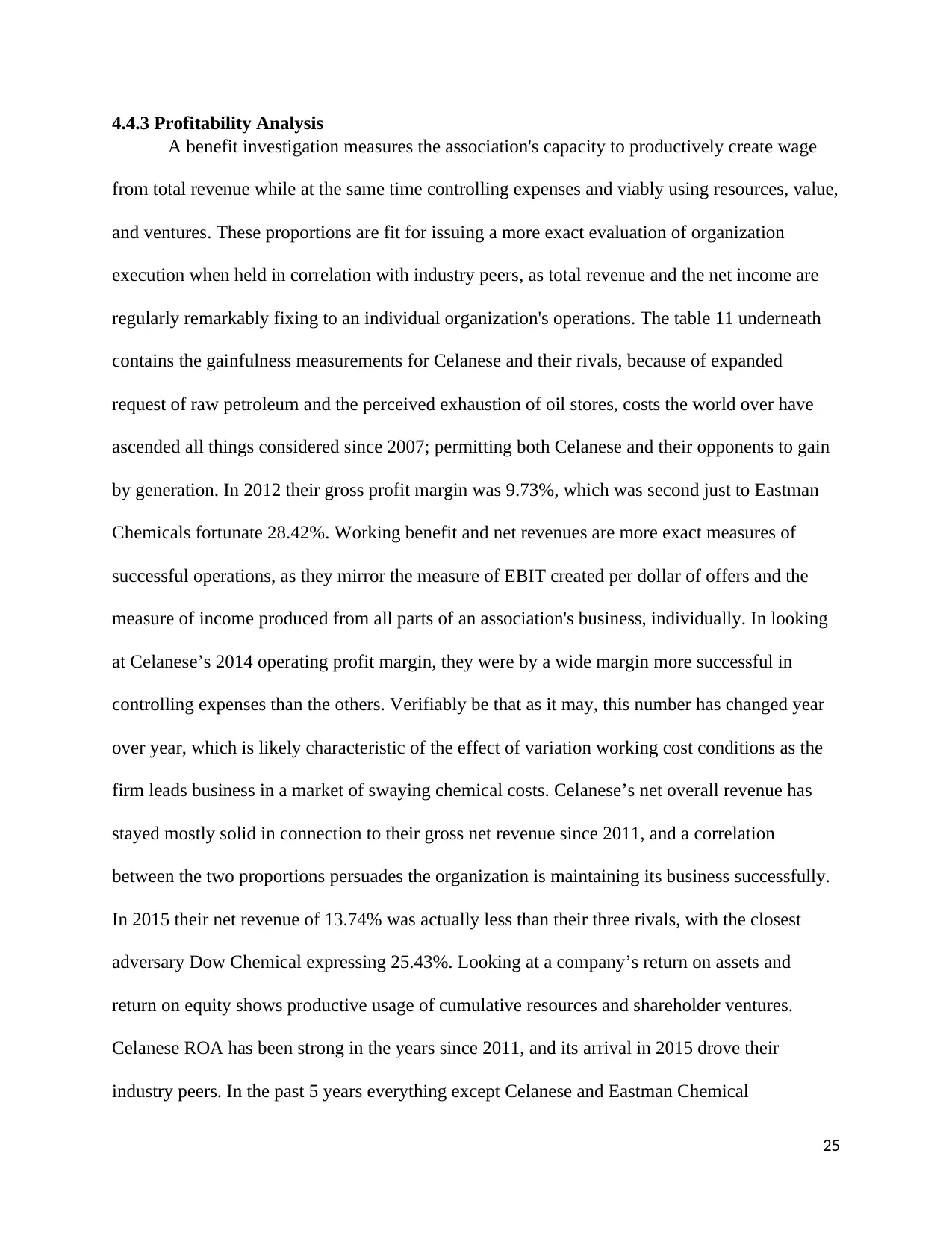
4.4.3 Profitability Analysis
A benefit investigation measures the association's capacity to productively create wage
from total revenue while at the same time controlling expenses and viably using resources, value,
and ventures. These proportions are fit for issuing a more exact evaluation of organization
execution when held in correlation with industry peers, as total revenue and the net income are
regularly remarkably fixing to an individual organization's operations. The table 11 underneath
contains the gainfulness measurements for Celanese and their rivals, because of expanded
request of raw petroleum and the perceived exhaustion of oil stores, costs the world over have
ascended all things considered since 2007; permitting both Celanese and their opponents to gain
by generation. In 2012 their gross profit margin was 9.73%, which was second just to Eastman
Chemicals fortunate 28.42%. Working benefit and net revenues are more exact measures of
successful operations, as they mirror the measure of EBIT created per dollar of offers and the
measure of income produced from all parts of an association's business, individually. In looking
at Celanese’s 2014 operating profit margin, they were by a wide margin more successful in
controlling expenses than the others. Verifiably be that as it may, this number has changed year
over year, which is likely characteristic of the effect of variation working cost conditions as the
firm leads business in a market of swaying chemical costs. Celanese’s net overall revenue has
stayed mostly solid in connection to their gross net revenue since 2011, and a correlation
between the two proportions persuades the organization is maintaining its business successfully.
In 2015 their net revenue of 13.74% was actually less than their three rivals, with the closest
adversary Dow Chemical expressing 25.43%. Looking at a company’s return on assets and
return on equity shows productive usage of cumulative resources and shareholder ventures.
Celanese ROA has been strong in the years since 2011, and its arrival in 2015 drove their
industry peers. In the past 5 years everything except Celanese and Eastman Chemical
25
A benefit investigation measures the association's capacity to productively create wage
from total revenue while at the same time controlling expenses and viably using resources, value,
and ventures. These proportions are fit for issuing a more exact evaluation of organization
execution when held in correlation with industry peers, as total revenue and the net income are
regularly remarkably fixing to an individual organization's operations. The table 11 underneath
contains the gainfulness measurements for Celanese and their rivals, because of expanded
request of raw petroleum and the perceived exhaustion of oil stores, costs the world over have
ascended all things considered since 2007; permitting both Celanese and their opponents to gain
by generation. In 2012 their gross profit margin was 9.73%, which was second just to Eastman
Chemicals fortunate 28.42%. Working benefit and net revenues are more exact measures of
successful operations, as they mirror the measure of EBIT created per dollar of offers and the
measure of income produced from all parts of an association's business, individually. In looking
at Celanese’s 2014 operating profit margin, they were by a wide margin more successful in
controlling expenses than the others. Verifiably be that as it may, this number has changed year
over year, which is likely characteristic of the effect of variation working cost conditions as the
firm leads business in a market of swaying chemical costs. Celanese’s net overall revenue has
stayed mostly solid in connection to their gross net revenue since 2011, and a correlation
between the two proportions persuades the organization is maintaining its business successfully.
In 2015 their net revenue of 13.74% was actually less than their three rivals, with the closest
adversary Dow Chemical expressing 25.43%. Looking at a company’s return on assets and
return on equity shows productive usage of cumulative resources and shareholder ventures.
Celanese ROA has been strong in the years since 2011, and its arrival in 2015 drove their
industry peers. In the past 5 years everything except Celanese and Eastman Chemical
25
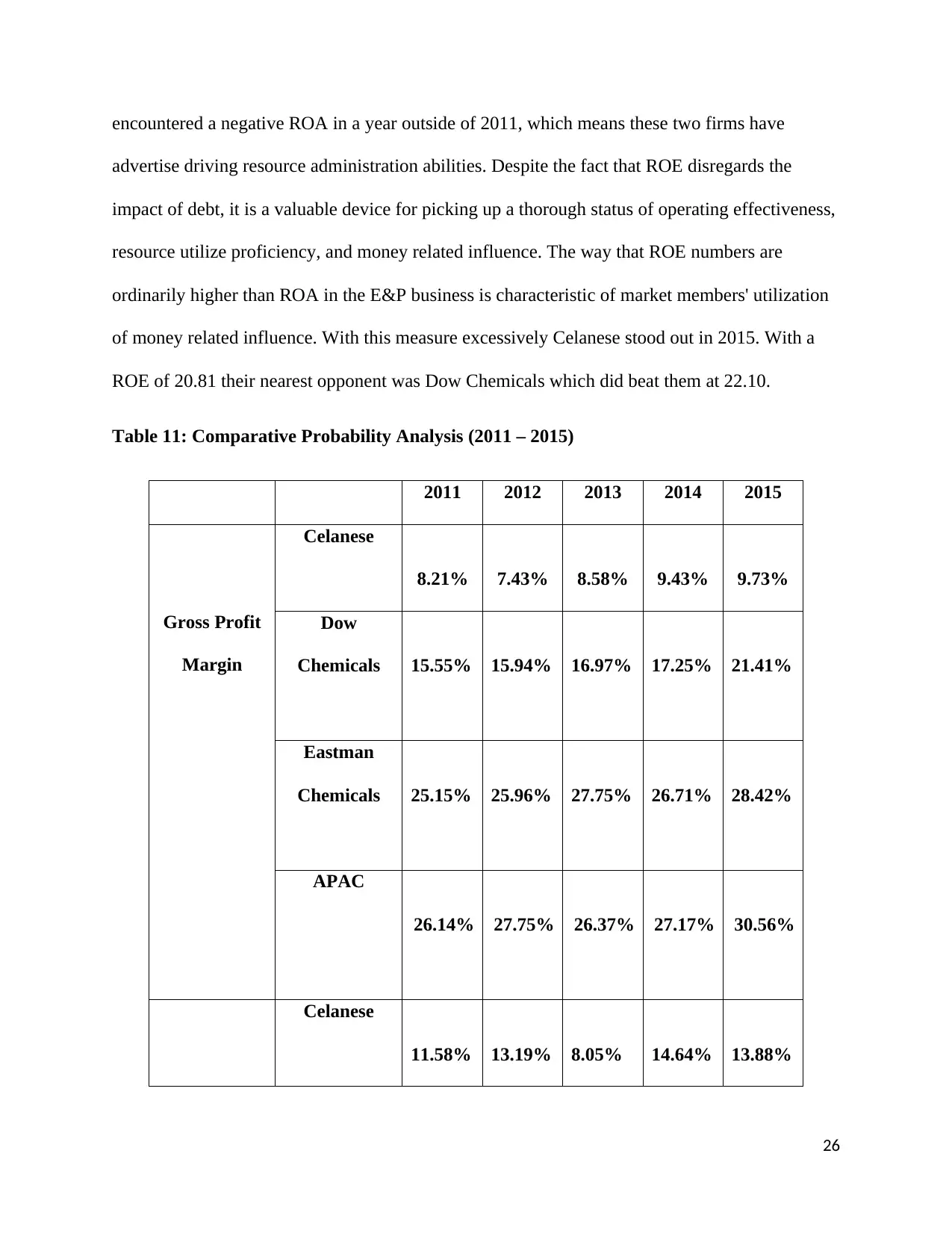
encountered a negative ROA in a year outside of 2011, which means these two firms have
advertise driving resource administration abilities. Despite the fact that ROE disregards the
impact of debt, it is a valuable device for picking up a thorough status of operating effectiveness,
resource utilize proficiency, and money related influence. The way that ROE numbers are
ordinarily higher than ROA in the E&P business is characteristic of market members' utilization
of money related influence. With this measure excessively Celanese stood out in 2015. With a
ROE of 20.81 their nearest opponent was Dow Chemicals which did beat them at 22.10.
Table 11: Comparative Probability Analysis (2011 – 2015)
2011 2012 2013 2014 2015
Gross Profit
Margin
Celanese
8.21% 7.43% 8.58% 9.43% 9.73%
Dow
Chemicals 15.55% 15.94% 16.97% 17.25% 21.41%
Eastman
Chemicals 25.15% 25.96% 27.75% 26.71% 28.42%
APAC
26.14% 27.75% 26.37% 27.17% 30.56%
Celanese
11.58% 13.19% 8.05% 14.64% 13.88%
26
advertise driving resource administration abilities. Despite the fact that ROE disregards the
impact of debt, it is a valuable device for picking up a thorough status of operating effectiveness,
resource utilize proficiency, and money related influence. The way that ROE numbers are
ordinarily higher than ROA in the E&P business is characteristic of market members' utilization
of money related influence. With this measure excessively Celanese stood out in 2015. With a
ROE of 20.81 their nearest opponent was Dow Chemicals which did beat them at 22.10.
Table 11: Comparative Probability Analysis (2011 – 2015)
2011 2012 2013 2014 2015
Gross Profit
Margin
Celanese
8.21% 7.43% 8.58% 9.43% 9.73%
Dow
Chemicals 15.55% 15.94% 16.97% 17.25% 21.41%
Eastman
Chemicals 25.15% 25.96% 27.75% 26.71% 28.42%
APAC
26.14% 27.75% 26.37% 27.17% 30.56%
Celanese
11.58% 13.19% 8.05% 14.64% 13.88%
26
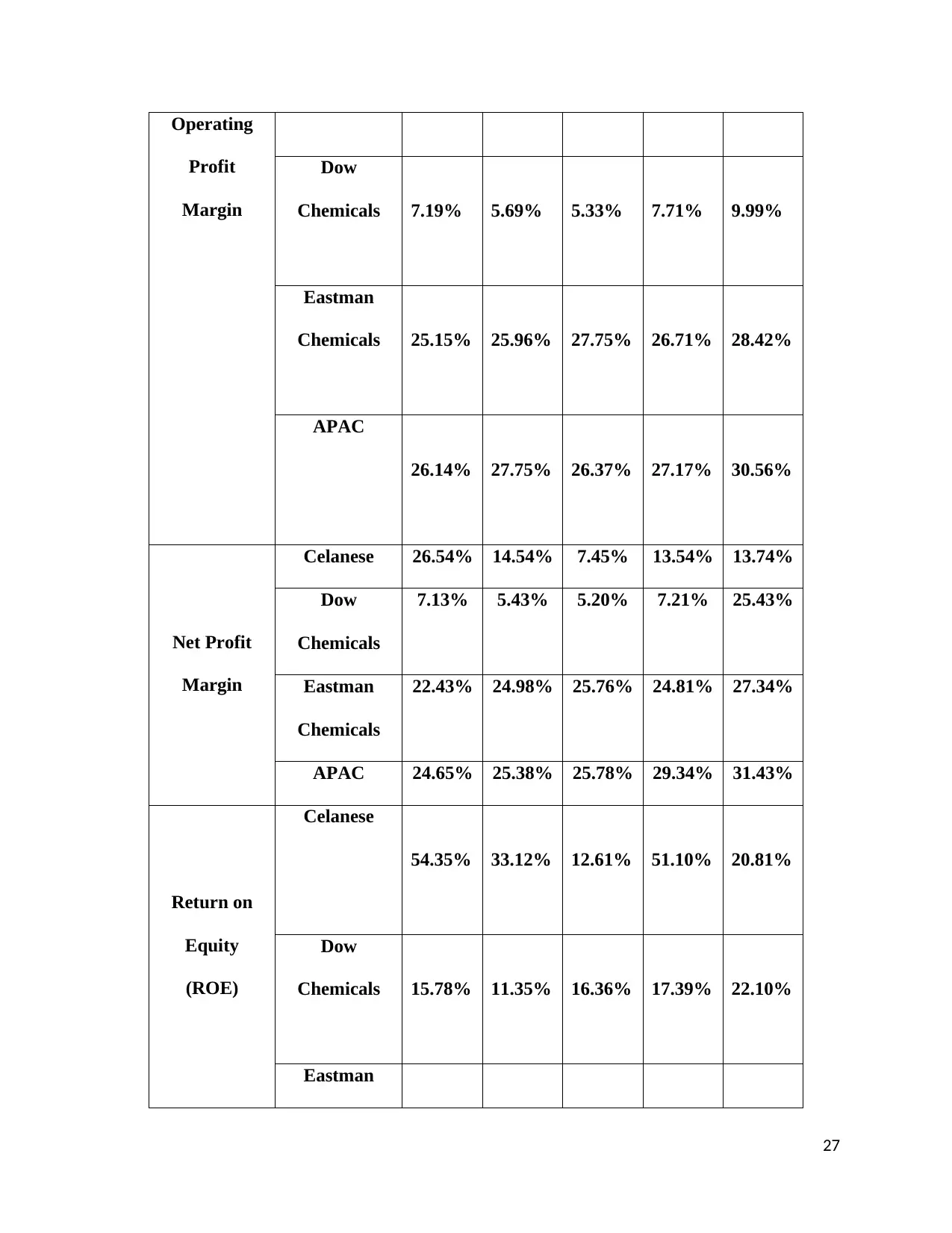
Operating
Profit
Margin
Dow
Chemicals 7.19% 5.69% 5.33% 7.71% 9.99%
Eastman
Chemicals 25.15% 25.96% 27.75% 26.71% 28.42%
APAC
26.14% 27.75% 26.37% 27.17% 30.56%
Net Profit
Margin
Celanese 26.54% 14.54% 7.45% 13.54% 13.74%
Dow
Chemicals
7.13% 5.43% 5.20% 7.21% 25.43%
Eastman
Chemicals
22.43% 24.98% 25.76% 24.81% 27.34%
APAC 24.65% 25.38% 25.78% 29.34% 31.43%
Return on
Equity
(ROE)
Celanese
54.35% 33.12% 12.61% 51.10% 20.81%
Dow
Chemicals 15.78% 11.35% 16.36% 17.39% 22.10%
Eastman
27
Profit
Margin
Dow
Chemicals 7.19% 5.69% 5.33% 7.71% 9.99%
Eastman
Chemicals 25.15% 25.96% 27.75% 26.71% 28.42%
APAC
26.14% 27.75% 26.37% 27.17% 30.56%
Net Profit
Margin
Celanese 26.54% 14.54% 7.45% 13.54% 13.74%
Dow
Chemicals
7.13% 5.43% 5.20% 7.21% 25.43%
Eastman
Chemicals
22.43% 24.98% 25.76% 24.81% 27.34%
APAC 24.65% 25.38% 25.78% 29.34% 31.43%
Return on
Equity
(ROE)
Celanese
54.35% 33.12% 12.61% 51.10% 20.81%
Dow
Chemicals 15.78% 11.35% 16.36% 17.39% 22.10%
Eastman
27
Secure Best Marks with AI Grader
Need help grading? Try our AI Grader for instant feedback on your assignments.
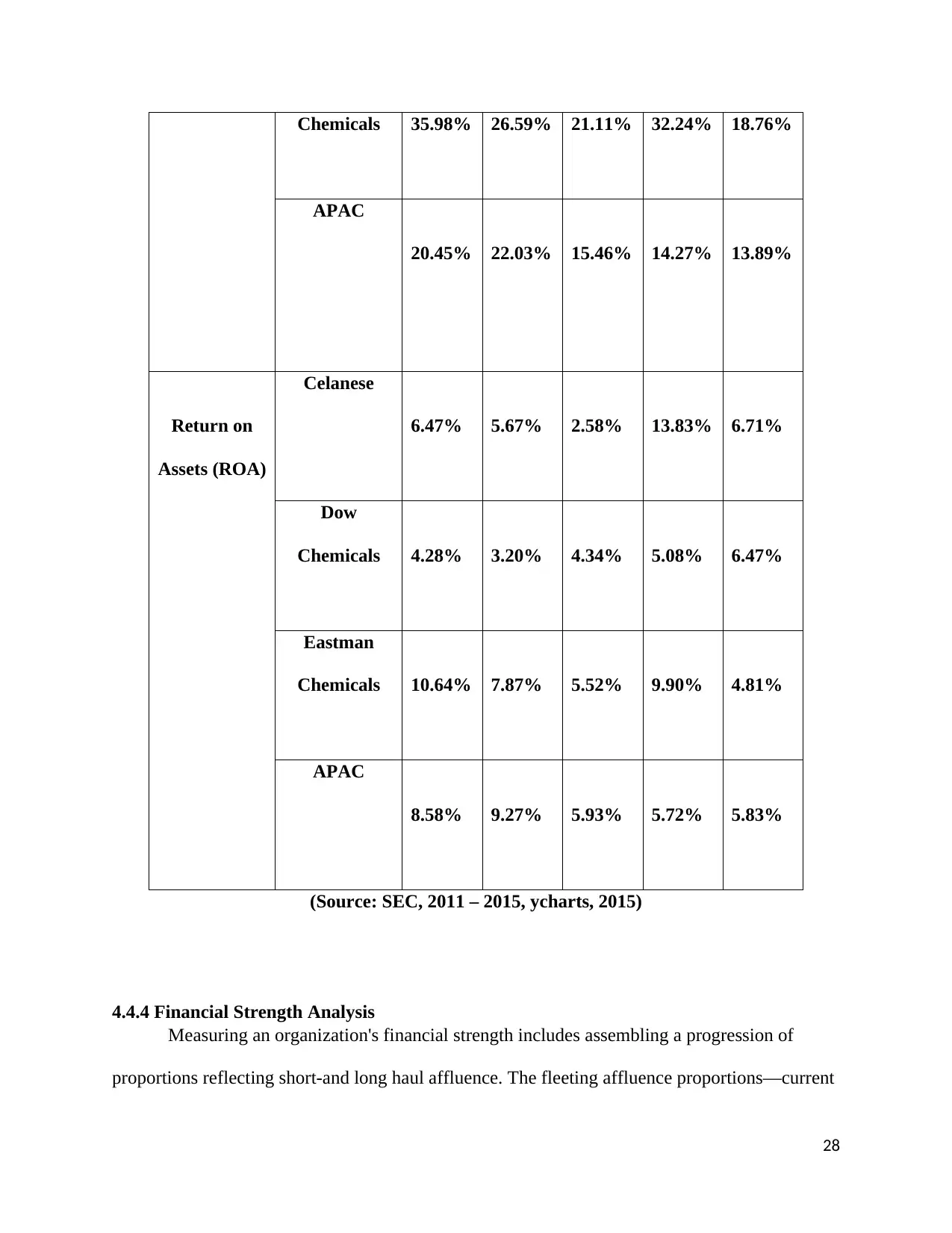
Chemicals 35.98% 26.59% 21.11% 32.24% 18.76%
APAC
20.45% 22.03% 15.46% 14.27% 13.89%
Return on
Assets (ROA)
Celanese
6.47% 5.67% 2.58% 13.83% 6.71%
Dow
Chemicals 4.28% 3.20% 4.34% 5.08% 6.47%
Eastman
Chemicals 10.64% 7.87% 5.52% 9.90% 4.81%
APAC
8.58% 9.27% 5.93% 5.72% 5.83%
(Source: SEC, 2011 – 2015, ycharts, 2015)
4.4.4 Financial Strength Analysis
Measuring an organization's financial strength includes assembling a progression of
proportions reflecting short-and long haul affluence. The fleeting affluence proportions—current
28
APAC
20.45% 22.03% 15.46% 14.27% 13.89%
Return on
Assets (ROA)
Celanese
6.47% 5.67% 2.58% 13.83% 6.71%
Dow
Chemicals 4.28% 3.20% 4.34% 5.08% 6.47%
Eastman
Chemicals 10.64% 7.87% 5.52% 9.90% 4.81%
APAC
8.58% 9.27% 5.93% 5.72% 5.83%
(Source: SEC, 2011 – 2015, ycharts, 2015)
4.4.4 Financial Strength Analysis
Measuring an organization's financial strength includes assembling a progression of
proportions reflecting short-and long haul affluence. The fleeting affluence proportions—current
28
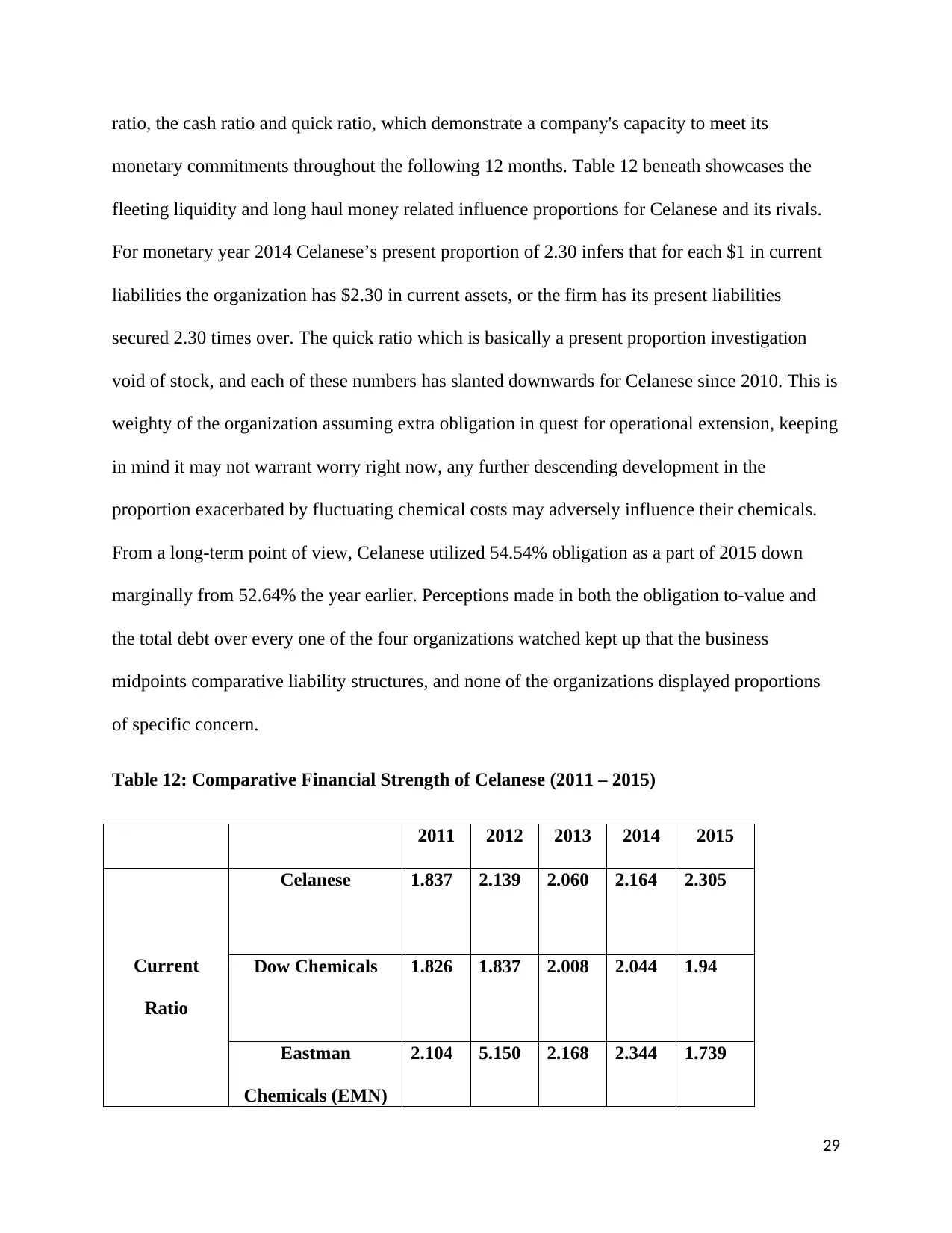
ratio, the cash ratio and quick ratio, which demonstrate a company's capacity to meet its
monetary commitments throughout the following 12 months. Table 12 beneath showcases the
fleeting liquidity and long haul money related influence proportions for Celanese and its rivals.
For monetary year 2014 Celanese’s present proportion of 2.30 infers that for each $1 in current
liabilities the organization has $2.30 in current assets, or the firm has its present liabilities
secured 2.30 times over. The quick ratio which is basically a present proportion investigation
void of stock, and each of these numbers has slanted downwards for Celanese since 2010. This is
weighty of the organization assuming extra obligation in quest for operational extension, keeping
in mind it may not warrant worry right now, any further descending development in the
proportion exacerbated by fluctuating chemical costs may adversely influence their chemicals.
From a long-term point of view, Celanese utilized 54.54% obligation as a part of 2015 down
marginally from 52.64% the year earlier. Perceptions made in both the obligation to-value and
the total debt over every one of the four organizations watched kept up that the business
midpoints comparative liability structures, and none of the organizations displayed proportions
of specific concern.
Table 12: Comparative Financial Strength of Celanese (2011 – 2015)
2011 2012 2013 2014 2015
Current
Ratio
Celanese 1.837 2.139 2.060 2.164 2.305
Dow Chemicals 1.826 1.837 2.008 2.044 1.94
Eastman
Chemicals (EMN)
2.104 5.150 2.168 2.344 1.739
29
monetary commitments throughout the following 12 months. Table 12 beneath showcases the
fleeting liquidity and long haul money related influence proportions for Celanese and its rivals.
For monetary year 2014 Celanese’s present proportion of 2.30 infers that for each $1 in current
liabilities the organization has $2.30 in current assets, or the firm has its present liabilities
secured 2.30 times over. The quick ratio which is basically a present proportion investigation
void of stock, and each of these numbers has slanted downwards for Celanese since 2010. This is
weighty of the organization assuming extra obligation in quest for operational extension, keeping
in mind it may not warrant worry right now, any further descending development in the
proportion exacerbated by fluctuating chemical costs may adversely influence their chemicals.
From a long-term point of view, Celanese utilized 54.54% obligation as a part of 2015 down
marginally from 52.64% the year earlier. Perceptions made in both the obligation to-value and
the total debt over every one of the four organizations watched kept up that the business
midpoints comparative liability structures, and none of the organizations displayed proportions
of specific concern.
Table 12: Comparative Financial Strength of Celanese (2011 – 2015)
2011 2012 2013 2014 2015
Current
Ratio
Celanese 1.837 2.139 2.060 2.164 2.305
Dow Chemicals 1.826 1.837 2.008 2.044 1.94
Eastman
Chemicals (EMN)
2.104 5.150 2.168 2.344 1.739
29
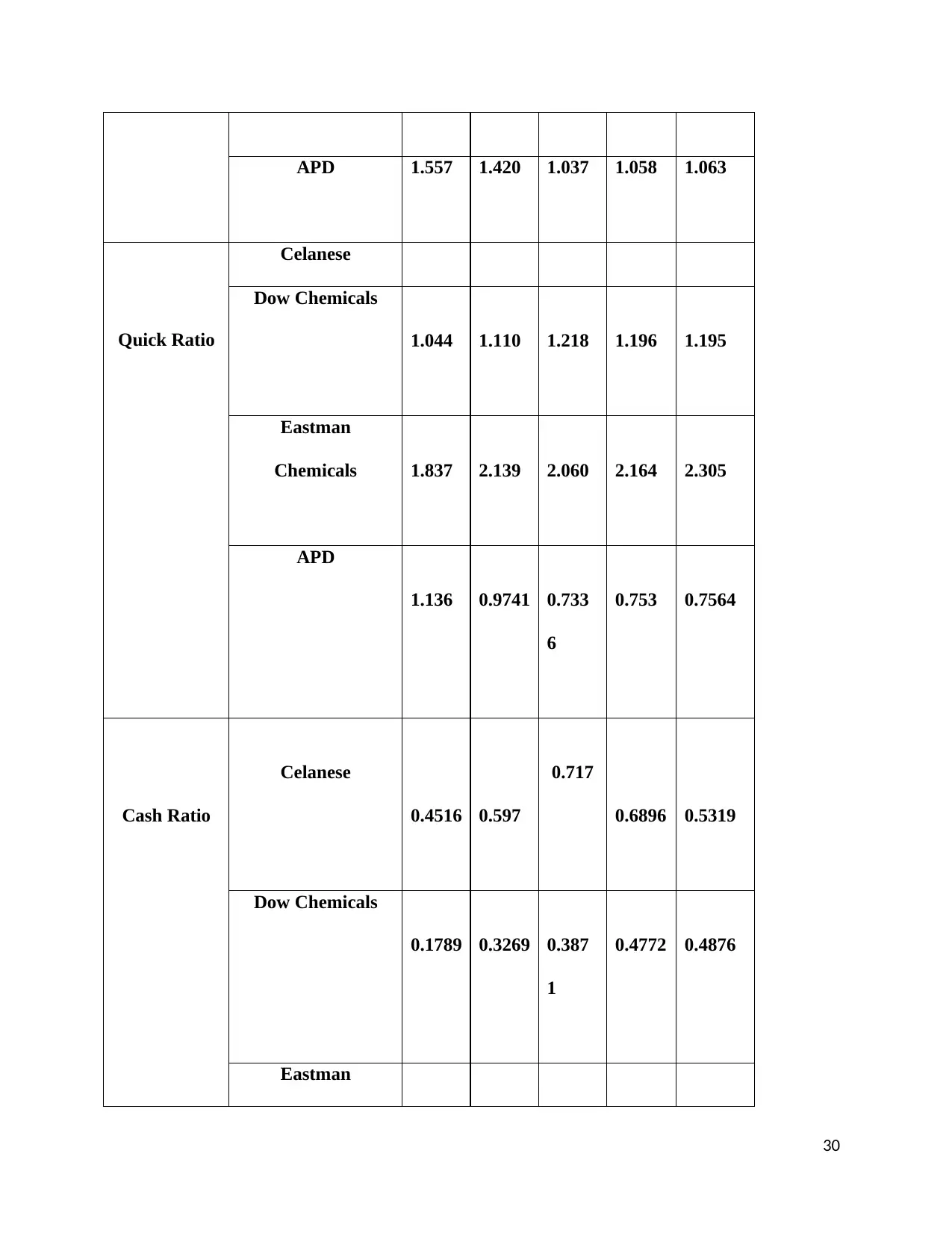
APD 1.557 1.420 1.037 1.058 1.063
Quick Ratio
Celanese
Dow Chemicals
1.044 1.110 1.218 1.196 1.195
Eastman
Chemicals 1.837 2.139 2.060 2.164 2.305
APD
1.136 0.9741 0.733
6
0.753 0.7564
Cash Ratio
Celanese
0.4516 0.597
0.717
0.6896 0.5319
Dow Chemicals
0.1789 0.3269 0.387
1
0.4772 0.4876
Eastman
30
Quick Ratio
Celanese
Dow Chemicals
1.044 1.110 1.218 1.196 1.195
Eastman
Chemicals 1.837 2.139 2.060 2.164 2.305
APD
1.136 0.9741 0.733
6
0.753 0.7564
Cash Ratio
Celanese
0.4516 0.597
0.717
0.6896 0.5319
Dow Chemicals
0.1789 0.3269 0.387
1
0.4772 0.4876
Eastman
30
Paraphrase This Document
Need a fresh take? Get an instant paraphrase of this document with our AI Paraphraser
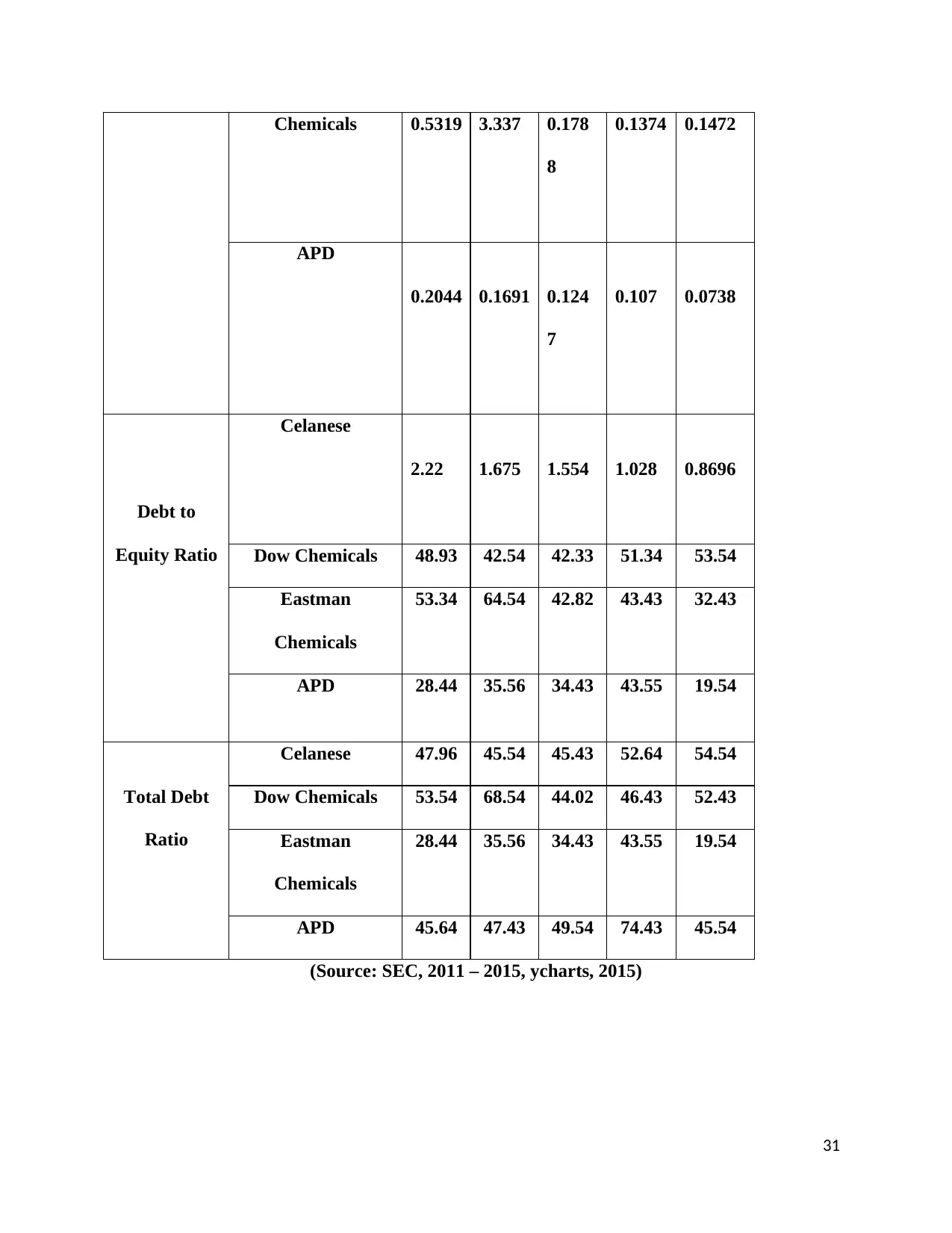
Chemicals 0.5319 3.337 0.178
8
0.1374 0.1472
APD
0.2044 0.1691 0.124
7
0.107 0.0738
Debt to
Equity Ratio
Celanese
2.22 1.675 1.554 1.028 0.8696
Dow Chemicals 48.93 42.54 42.33 51.34 53.54
Eastman
Chemicals
53.34 64.54 42.82 43.43 32.43
APD 28.44 35.56 34.43 43.55 19.54
Total Debt
Ratio
Celanese 47.96 45.54 45.43 52.64 54.54
Dow Chemicals 53.54 68.54 44.02 46.43 52.43
Eastman
Chemicals
28.44 35.56 34.43 43.55 19.54
APD 45.64 47.43 49.54 74.43 45.54
(Source: SEC, 2011 – 2015, ycharts, 2015)
31
8
0.1374 0.1472
APD
0.2044 0.1691 0.124
7
0.107 0.0738
Debt to
Equity Ratio
Celanese
2.22 1.675 1.554 1.028 0.8696
Dow Chemicals 48.93 42.54 42.33 51.34 53.54
Eastman
Chemicals
53.34 64.54 42.82 43.43 32.43
APD 28.44 35.56 34.43 43.55 19.54
Total Debt
Ratio
Celanese 47.96 45.54 45.43 52.64 54.54
Dow Chemicals 53.54 68.54 44.02 46.43 52.43
Eastman
Chemicals
28.44 35.56 34.43 43.55 19.54
APD 45.64 47.43 49.54 74.43 45.54
(Source: SEC, 2011 – 2015, ycharts, 2015)
31
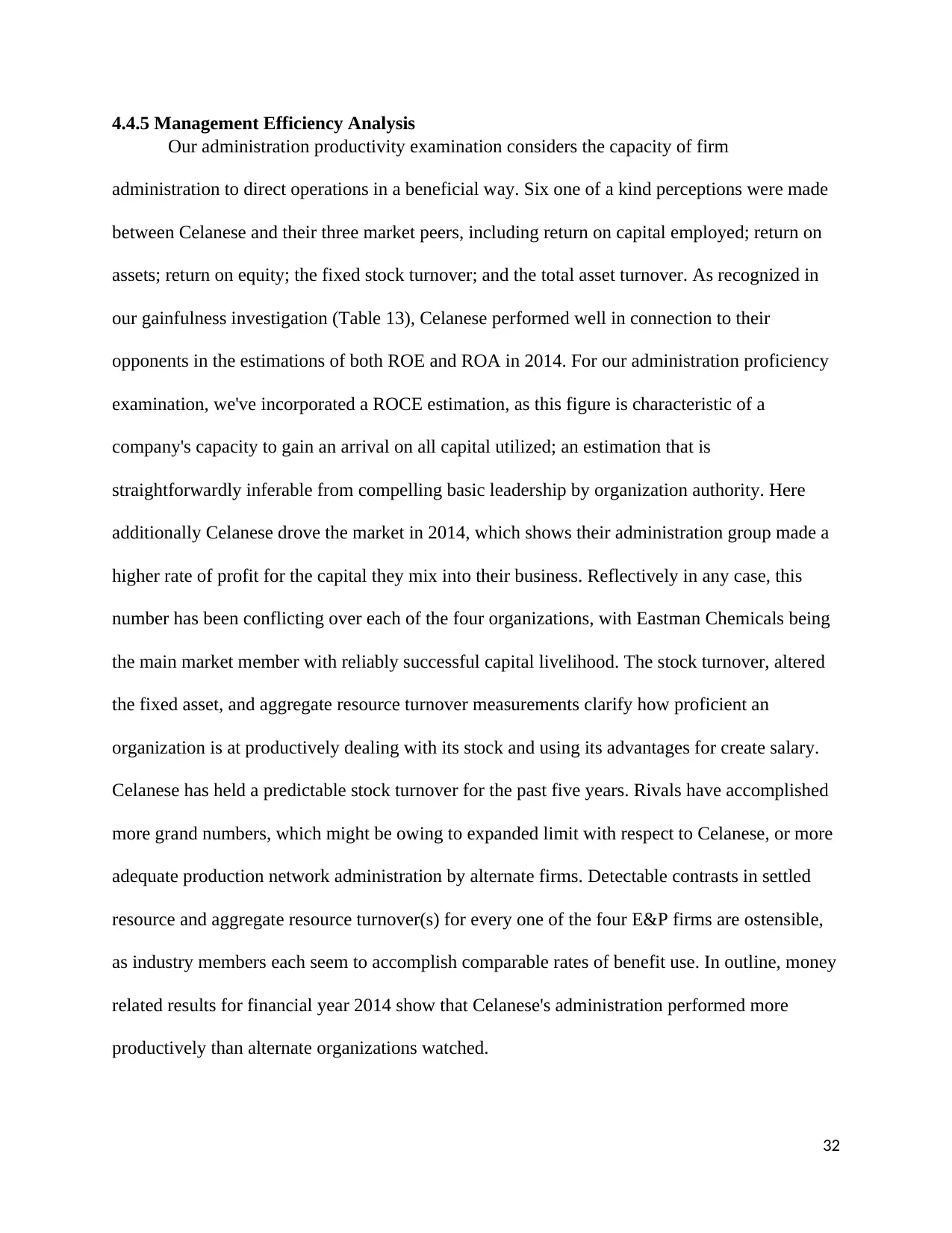
4.4.5 Management Efficiency Analysis
Our administration productivity examination considers the capacity of firm
administration to direct operations in a beneficial way. Six one of a kind perceptions were made
between Celanese and their three market peers, including return on capital employed; return on
assets; return on equity; the fixed stock turnover; and the total asset turnover. As recognized in
our gainfulness investigation (Table 13), Celanese performed well in connection to their
opponents in the estimations of both ROE and ROA in 2014. For our administration proficiency
examination, we've incorporated a ROCE estimation, as this figure is characteristic of a
company's capacity to gain an arrival on all capital utilized; an estimation that is
straightforwardly inferable from compelling basic leadership by organization authority. Here
additionally Celanese drove the market in 2014, which shows their administration group made a
higher rate of profit for the capital they mix into their business. Reflectively in any case, this
number has been conflicting over each of the four organizations, with Eastman Chemicals being
the main market member with reliably successful capital livelihood. The stock turnover, altered
the fixed asset, and aggregate resource turnover measurements clarify how proficient an
organization is at productively dealing with its stock and using its advantages for create salary.
Celanese has held a predictable stock turnover for the past five years. Rivals have accomplished
more grand numbers, which might be owing to expanded limit with respect to Celanese, or more
adequate production network administration by alternate firms. Detectable contrasts in settled
resource and aggregate resource turnover(s) for every one of the four E&P firms are ostensible,
as industry members each seem to accomplish comparable rates of benefit use. In outline, money
related results for financial year 2014 show that Celanese's administration performed more
productively than alternate organizations watched.
32
Our administration productivity examination considers the capacity of firm
administration to direct operations in a beneficial way. Six one of a kind perceptions were made
between Celanese and their three market peers, including return on capital employed; return on
assets; return on equity; the fixed stock turnover; and the total asset turnover. As recognized in
our gainfulness investigation (Table 13), Celanese performed well in connection to their
opponents in the estimations of both ROE and ROA in 2014. For our administration proficiency
examination, we've incorporated a ROCE estimation, as this figure is characteristic of a
company's capacity to gain an arrival on all capital utilized; an estimation that is
straightforwardly inferable from compelling basic leadership by organization authority. Here
additionally Celanese drove the market in 2014, which shows their administration group made a
higher rate of profit for the capital they mix into their business. Reflectively in any case, this
number has been conflicting over each of the four organizations, with Eastman Chemicals being
the main market member with reliably successful capital livelihood. The stock turnover, altered
the fixed asset, and aggregate resource turnover measurements clarify how proficient an
organization is at productively dealing with its stock and using its advantages for create salary.
Celanese has held a predictable stock turnover for the past five years. Rivals have accomplished
more grand numbers, which might be owing to expanded limit with respect to Celanese, or more
adequate production network administration by alternate firms. Detectable contrasts in settled
resource and aggregate resource turnover(s) for every one of the four E&P firms are ostensible,
as industry members each seem to accomplish comparable rates of benefit use. In outline, money
related results for financial year 2014 show that Celanese's administration performed more
productively than alternate organizations watched.
32
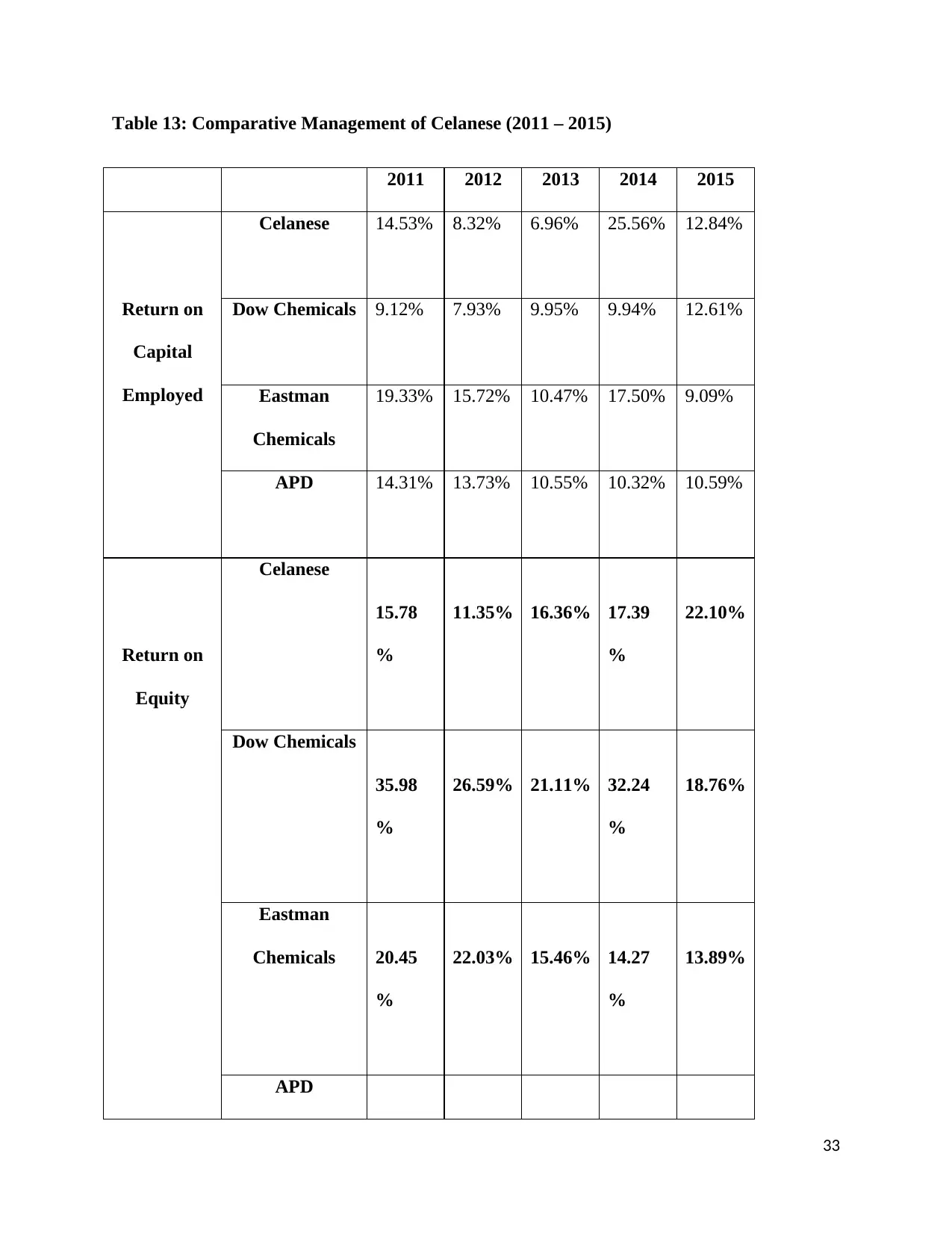
Table 13: Comparative Management of Celanese (2011 – 2015)
2011 2012 2013 2014 2015
Return on
Capital
Employed
Celanese 14.53% 8.32% 6.96% 25.56% 12.84%
Dow Chemicals 9.12% 7.93% 9.95% 9.94% 12.61%
Eastman
Chemicals
19.33% 15.72% 10.47% 17.50% 9.09%
APD 14.31% 13.73% 10.55% 10.32% 10.59%
Return on
Equity
Celanese
15.78
%
11.35% 16.36% 17.39
%
22.10%
Dow Chemicals
35.98
%
26.59% 21.11% 32.24
%
18.76%
Eastman
Chemicals 20.45
%
22.03% 15.46% 14.27
%
13.89%
APD
33
2011 2012 2013 2014 2015
Return on
Capital
Employed
Celanese 14.53% 8.32% 6.96% 25.56% 12.84%
Dow Chemicals 9.12% 7.93% 9.95% 9.94% 12.61%
Eastman
Chemicals
19.33% 15.72% 10.47% 17.50% 9.09%
APD 14.31% 13.73% 10.55% 10.32% 10.59%
Return on
Equity
Celanese
15.78
%
11.35% 16.36% 17.39
%
22.10%
Dow Chemicals
35.98
%
26.59% 21.11% 32.24
%
18.76%
Eastman
Chemicals 20.45
%
22.03% 15.46% 14.27
%
13.89%
APD
33
Secure Best Marks with AI Grader
Need help grading? Try our AI Grader for instant feedback on your assignments.
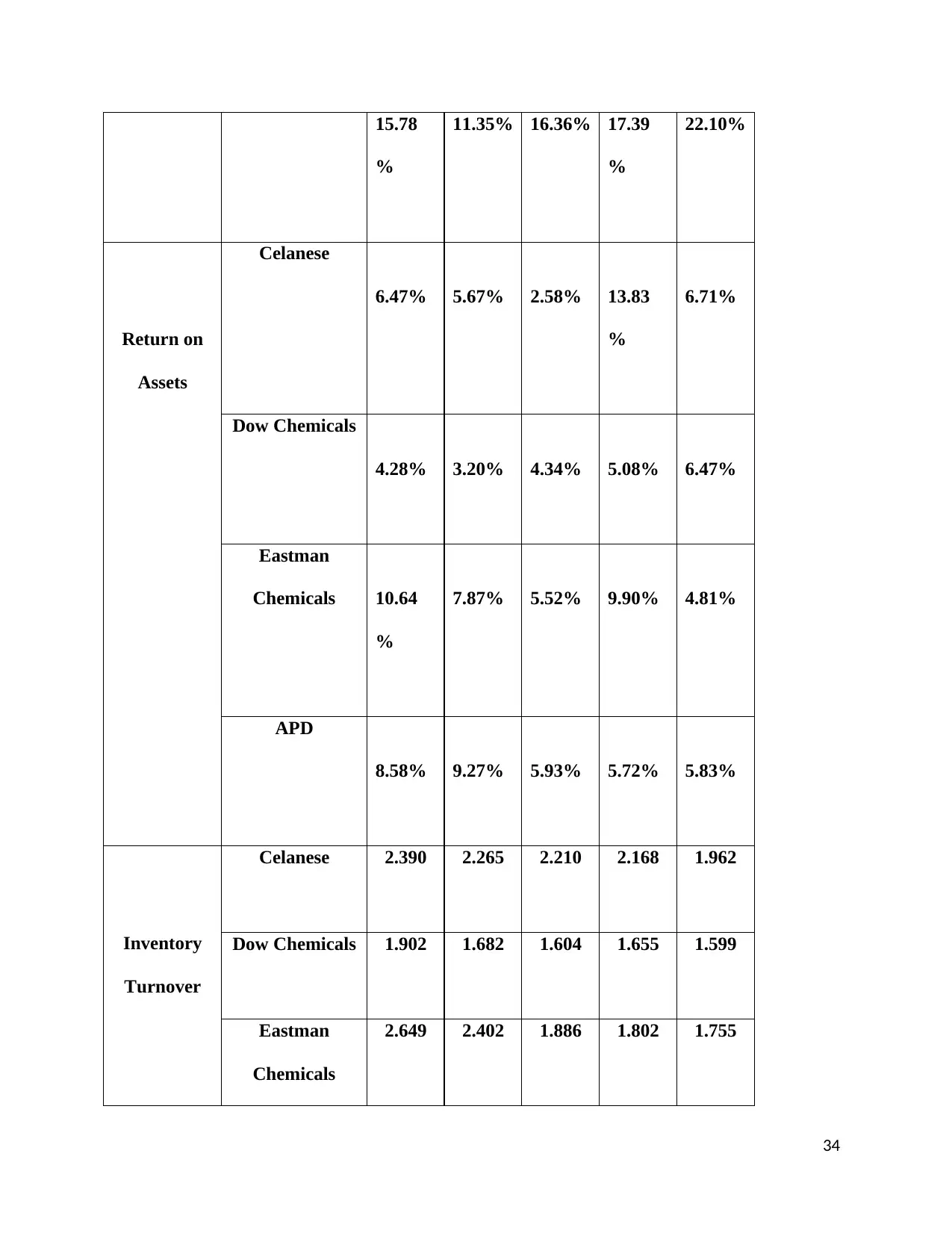
15.78
%
11.35% 16.36% 17.39
%
22.10%
Return on
Assets
Celanese
6.47% 5.67% 2.58% 13.83
%
6.71%
Dow Chemicals
4.28% 3.20% 4.34% 5.08% 6.47%
Eastman
Chemicals 10.64
%
7.87% 5.52% 9.90% 4.81%
APD
8.58% 9.27% 5.93% 5.72% 5.83%
Inventory
Turnover
Celanese 2.390 2.265 2.210 2.168 1.962
Dow Chemicals 1.902 1.682 1.604 1.655 1.599
Eastman
Chemicals
2.649 2.402 1.886 1.802 1.755
34
%
11.35% 16.36% 17.39
%
22.10%
Return on
Assets
Celanese
6.47% 5.67% 2.58% 13.83
%
6.71%
Dow Chemicals
4.28% 3.20% 4.34% 5.08% 6.47%
Eastman
Chemicals 10.64
%
7.87% 5.52% 9.90% 4.81%
APD
8.58% 9.27% 5.93% 5.72% 5.83%
Inventory
Turnover
Celanese 2.390 2.265 2.210 2.168 1.962
Dow Chemicals 1.902 1.682 1.604 1.655 1.599
Eastman
Chemicals
2.649 2.402 1.886 1.802 1.755
34
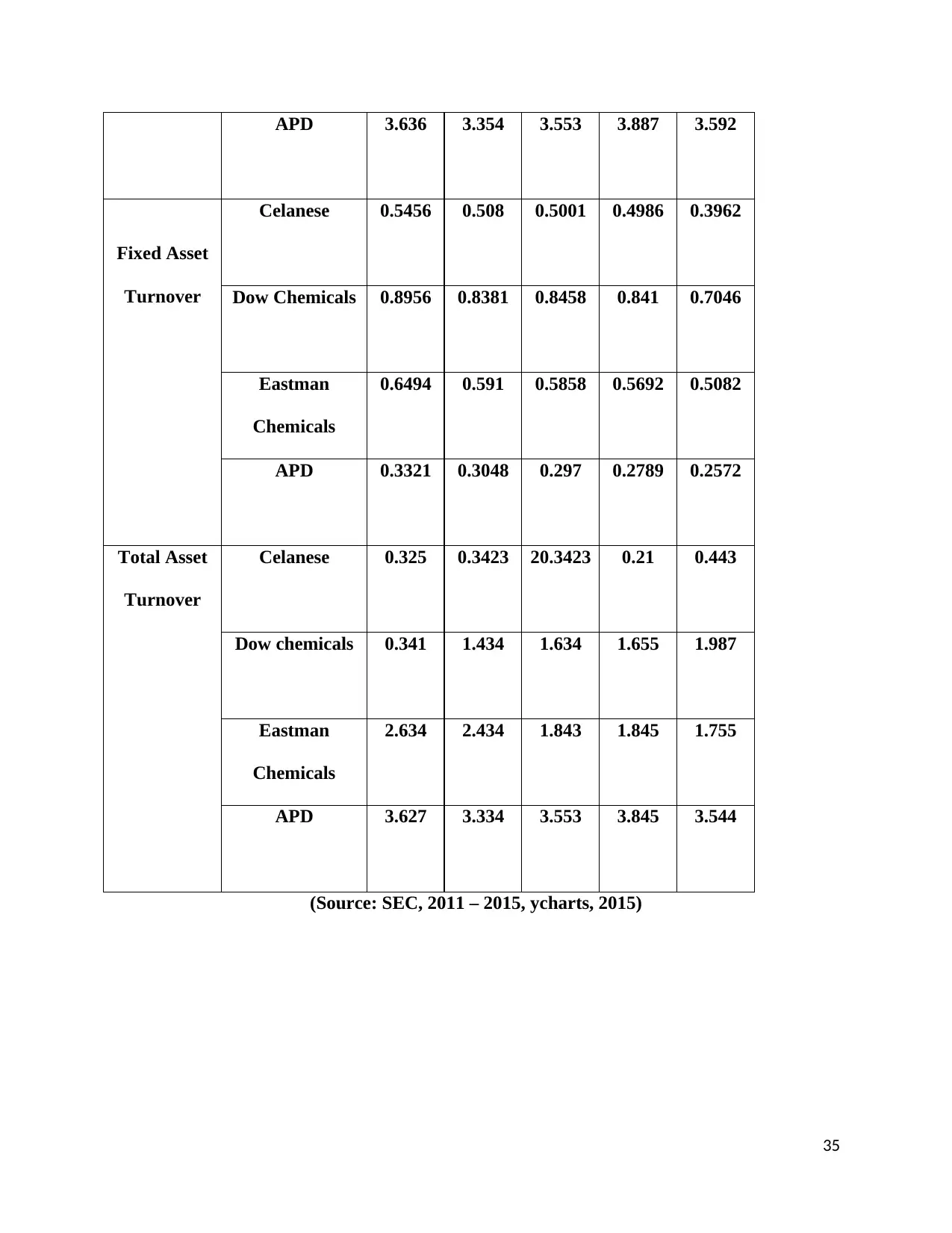
APD 3.636 3.354 3.553 3.887 3.592
Fixed Asset
Turnover
Celanese 0.5456 0.508 0.5001 0.4986 0.3962
Dow Chemicals 0.8956 0.8381 0.8458 0.841 0.7046
Eastman
Chemicals
0.6494 0.591 0.5858 0.5692 0.5082
APD 0.3321 0.3048 0.297 0.2789 0.2572
Total Asset
Turnover
Celanese 0.325 0.3423 20.3423 0.21 0.443
Dow chemicals 0.341 1.434 1.634 1.655 1.987
Eastman
Chemicals
2.634 2.434 1.843 1.845 1.755
APD 3.627 3.334 3.553 3.845 3.544
(Source: SEC, 2011 – 2015, ycharts, 2015)
35
Fixed Asset
Turnover
Celanese 0.5456 0.508 0.5001 0.4986 0.3962
Dow Chemicals 0.8956 0.8381 0.8458 0.841 0.7046
Eastman
Chemicals
0.6494 0.591 0.5858 0.5692 0.5082
APD 0.3321 0.3048 0.297 0.2789 0.2572
Total Asset
Turnover
Celanese 0.325 0.3423 20.3423 0.21 0.443
Dow chemicals 0.341 1.434 1.634 1.655 1.987
Eastman
Chemicals
2.634 2.434 1.843 1.845 1.755
APD 3.627 3.334 3.553 3.845 3.544
(Source: SEC, 2011 – 2015, ycharts, 2015)
35
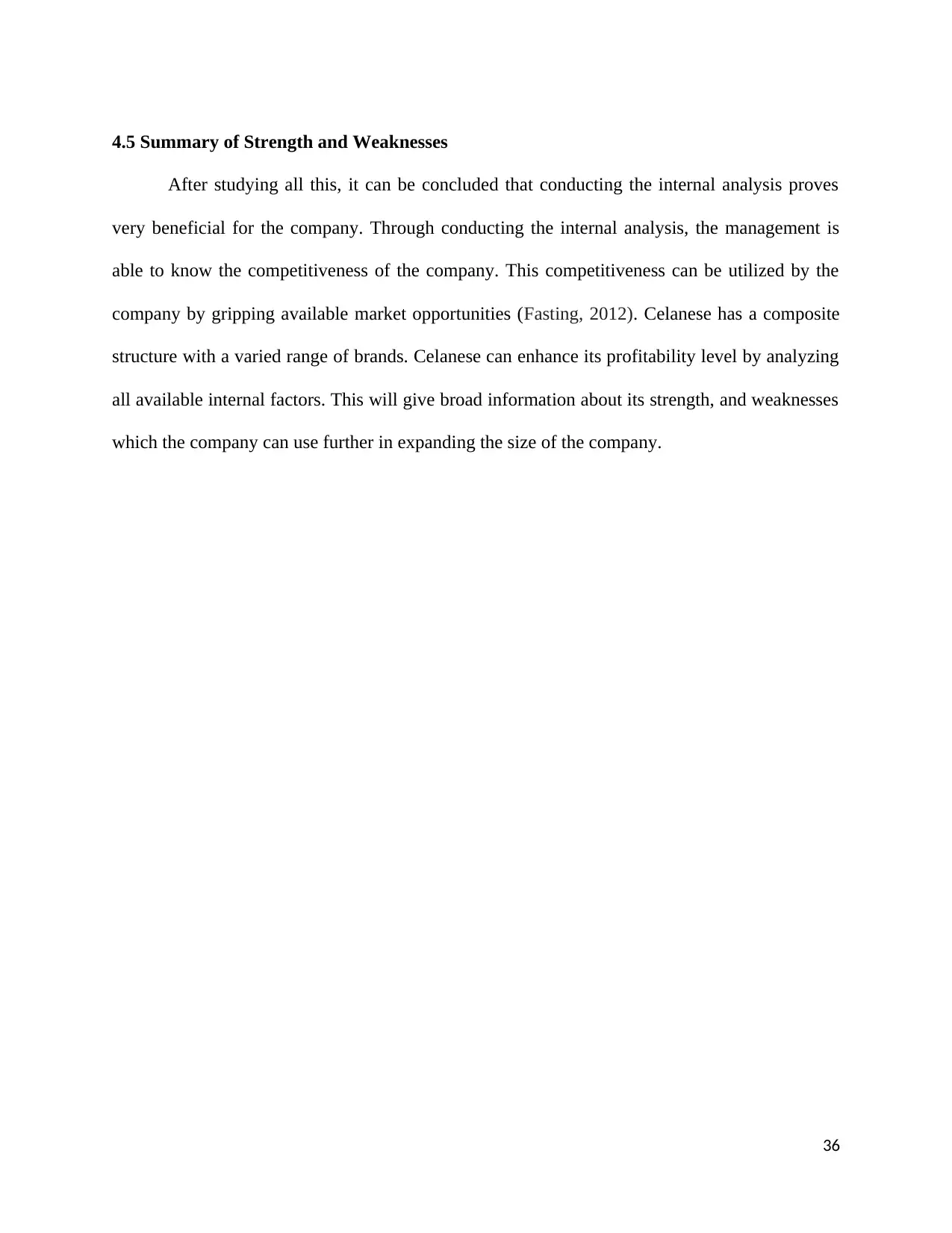
4.5 Summary of Strength and Weaknesses
After studying all this, it can be concluded that conducting the internal analysis proves
very beneficial for the company. Through conducting the internal analysis, the management is
able to know the competitiveness of the company. This competitiveness can be utilized by the
company by gripping available market opportunities (Fasting, 2012). Celanese has a composite
structure with a varied range of brands. Celanese can enhance its profitability level by analyzing
all available internal factors. This will give broad information about its strength, and weaknesses
which the company can use further in expanding the size of the company.
36
After studying all this, it can be concluded that conducting the internal analysis proves
very beneficial for the company. Through conducting the internal analysis, the management is
able to know the competitiveness of the company. This competitiveness can be utilized by the
company by gripping available market opportunities (Fasting, 2012). Celanese has a composite
structure with a varied range of brands. Celanese can enhance its profitability level by analyzing
all available internal factors. This will give broad information about its strength, and weaknesses
which the company can use further in expanding the size of the company.
36
Paraphrase This Document
Need a fresh take? Get an instant paraphrase of this document with our AI Paraphraser
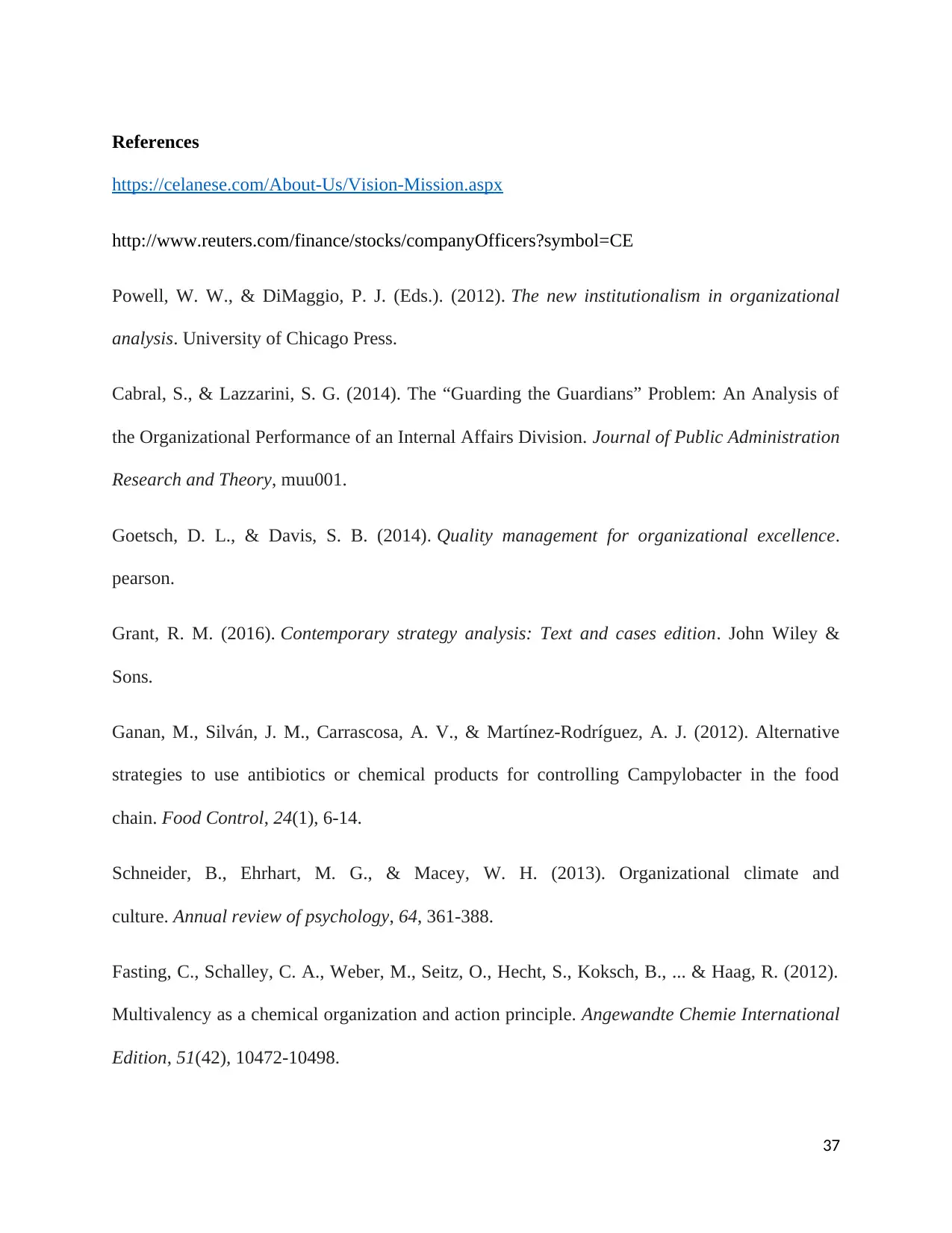
References
https://celanese.com/About-Us/Vision-Mission.aspx
http://www.reuters.com/finance/stocks/companyOfficers?symbol=CE
Powell, W. W., & DiMaggio, P. J. (Eds.). (2012). The new institutionalism in organizational
analysis. University of Chicago Press.
Cabral, S., & Lazzarini, S. G. (2014). The “Guarding the Guardians” Problem: An Analysis of
the Organizational Performance of an Internal Affairs Division. Journal of Public Administration
Research and Theory, muu001.
Goetsch, D. L., & Davis, S. B. (2014). Quality management for organizational excellence.
pearson.
Grant, R. M. (2016). Contemporary strategy analysis: Text and cases edition. John Wiley &
Sons.
Ganan, M., Silván, J. M., Carrascosa, A. V., & Martínez-Rodríguez, A. J. (2012). Alternative
strategies to use antibiotics or chemical products for controlling Campylobacter in the food
chain. Food Control, 24(1), 6-14.
Schneider, B., Ehrhart, M. G., & Macey, W. H. (2013). Organizational climate and
culture. Annual review of psychology, 64, 361-388.
Fasting, C., Schalley, C. A., Weber, M., Seitz, O., Hecht, S., Koksch, B., ... & Haag, R. (2012).
Multivalency as a chemical organization and action principle. Angewandte Chemie International
Edition, 51(42), 10472-10498.
37
https://celanese.com/About-Us/Vision-Mission.aspx
http://www.reuters.com/finance/stocks/companyOfficers?symbol=CE
Powell, W. W., & DiMaggio, P. J. (Eds.). (2012). The new institutionalism in organizational
analysis. University of Chicago Press.
Cabral, S., & Lazzarini, S. G. (2014). The “Guarding the Guardians” Problem: An Analysis of
the Organizational Performance of an Internal Affairs Division. Journal of Public Administration
Research and Theory, muu001.
Goetsch, D. L., & Davis, S. B. (2014). Quality management for organizational excellence.
pearson.
Grant, R. M. (2016). Contemporary strategy analysis: Text and cases edition. John Wiley &
Sons.
Ganan, M., Silván, J. M., Carrascosa, A. V., & Martínez-Rodríguez, A. J. (2012). Alternative
strategies to use antibiotics or chemical products for controlling Campylobacter in the food
chain. Food Control, 24(1), 6-14.
Schneider, B., Ehrhart, M. G., & Macey, W. H. (2013). Organizational climate and
culture. Annual review of psychology, 64, 361-388.
Fasting, C., Schalley, C. A., Weber, M., Seitz, O., Hecht, S., Koksch, B., ... & Haag, R. (2012).
Multivalency as a chemical organization and action principle. Angewandte Chemie International
Edition, 51(42), 10472-10498.
37
1 out of 38
Related Documents
Your All-in-One AI-Powered Toolkit for Academic Success.
+13062052269
info@desklib.com
Available 24*7 on WhatsApp / Email
![[object Object]](/_next/static/media/star-bottom.7253800d.svg)
Unlock your academic potential
© 2024 | Zucol Services PVT LTD | All rights reserved.





